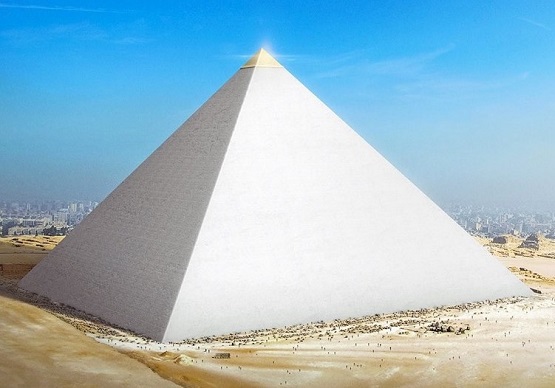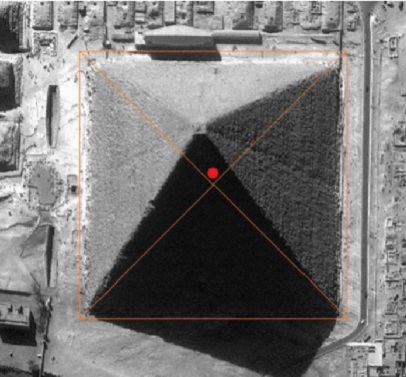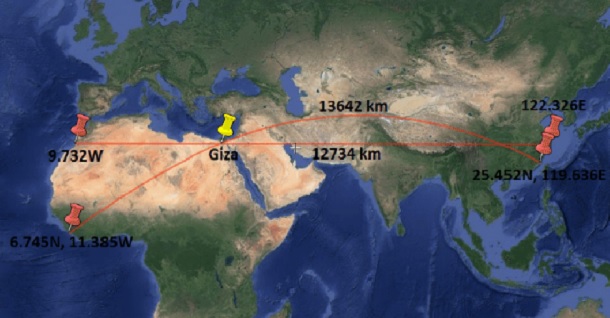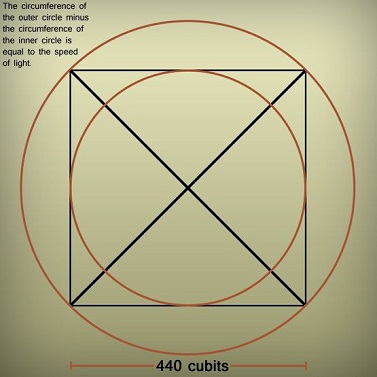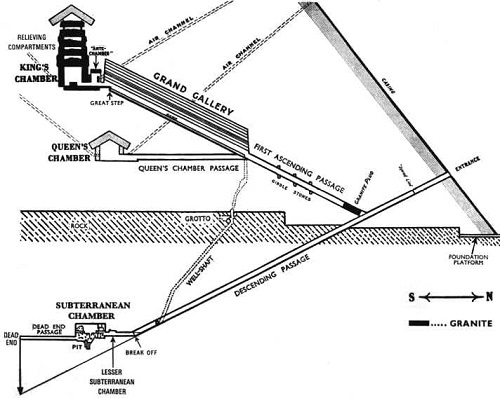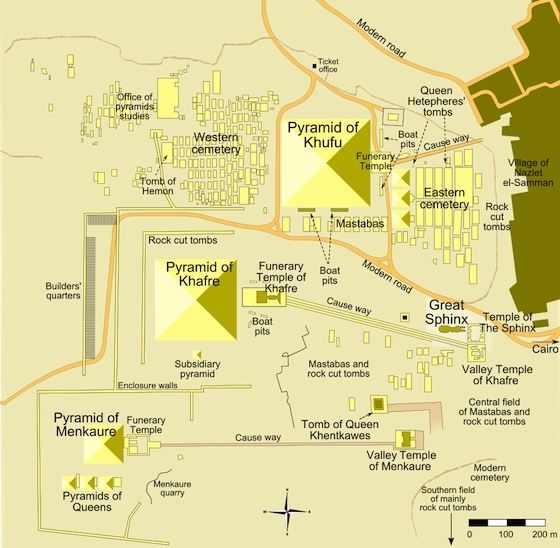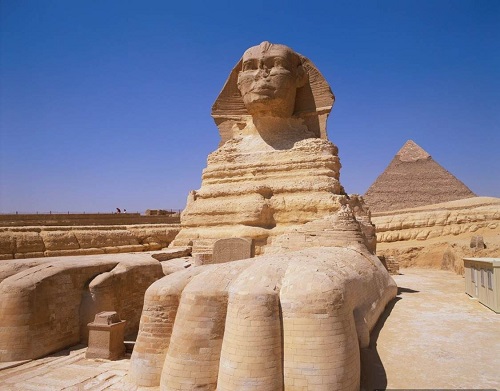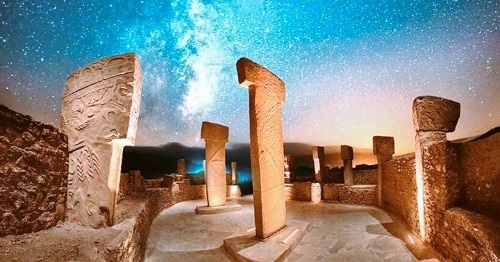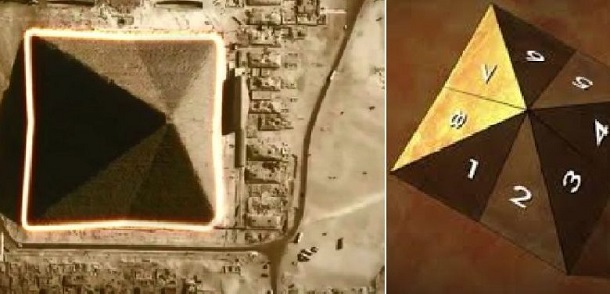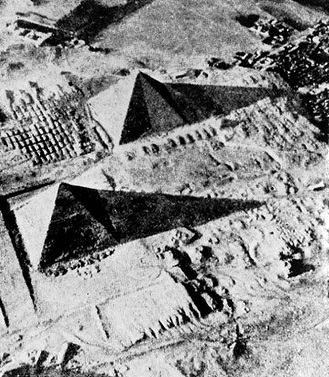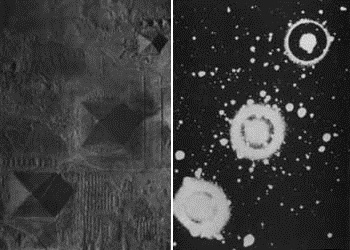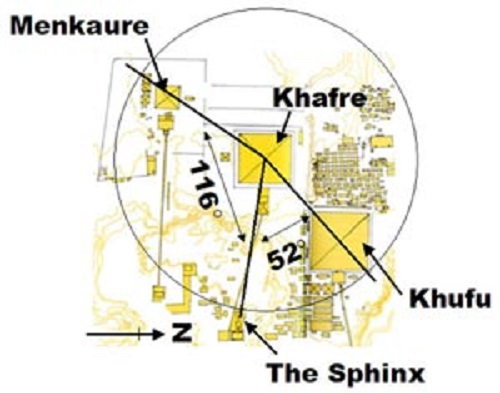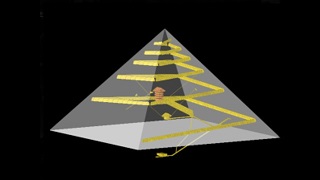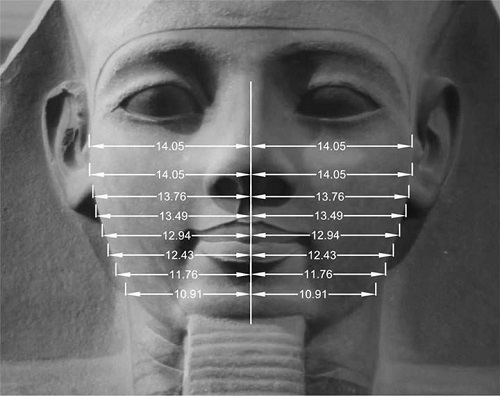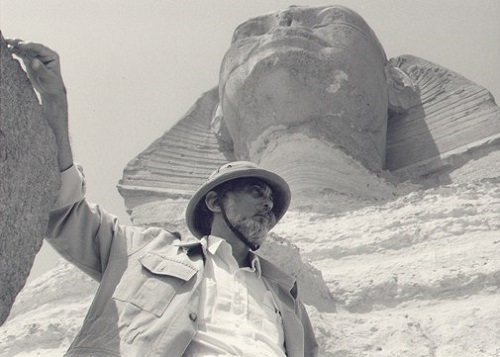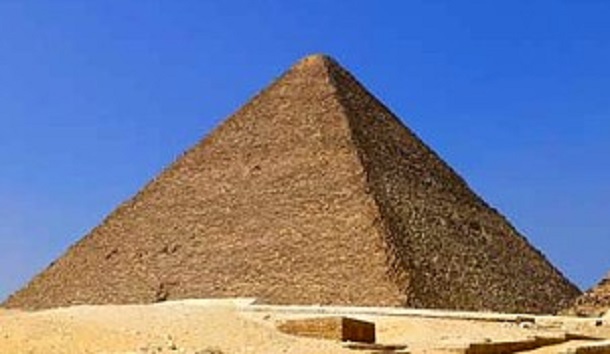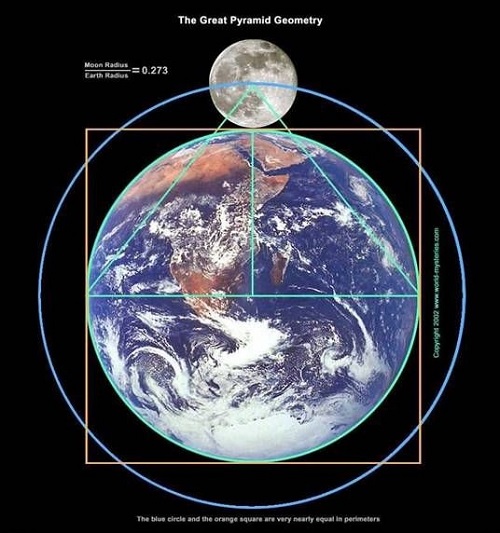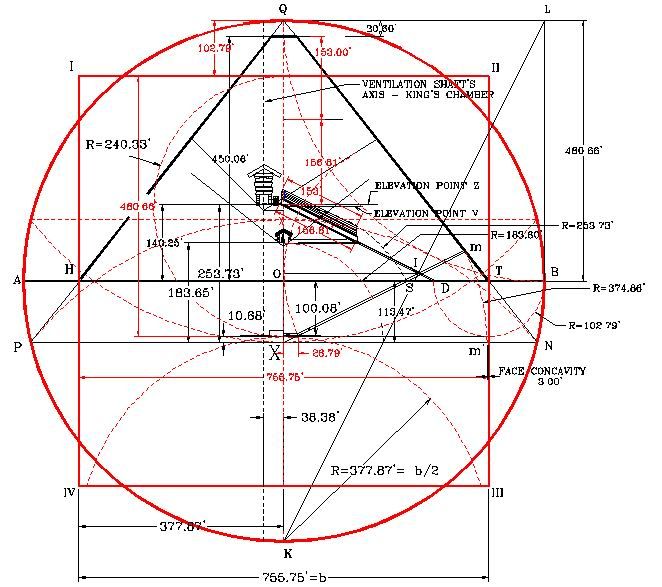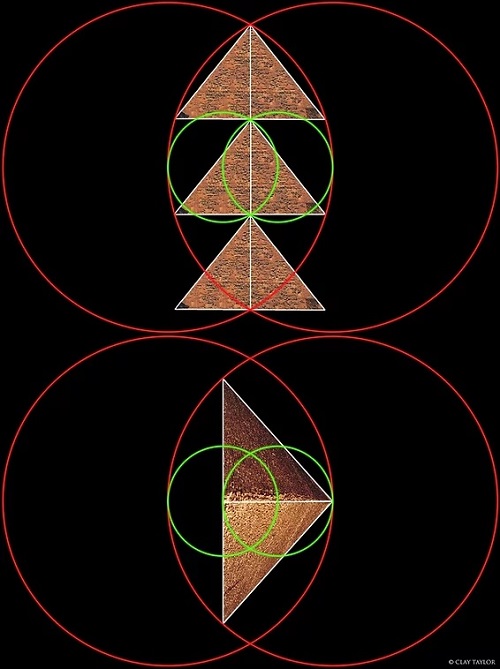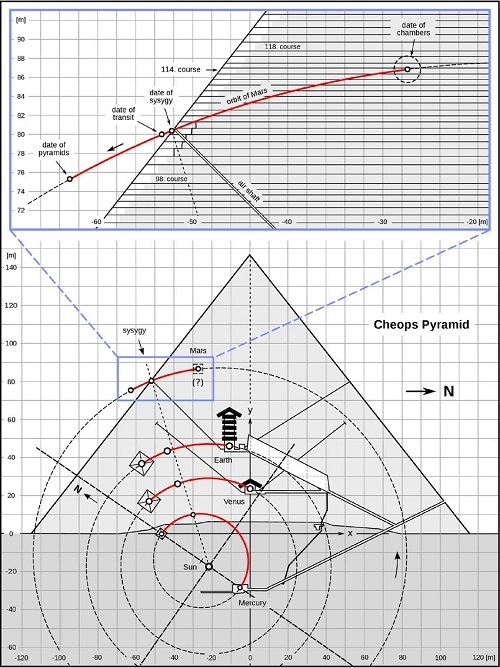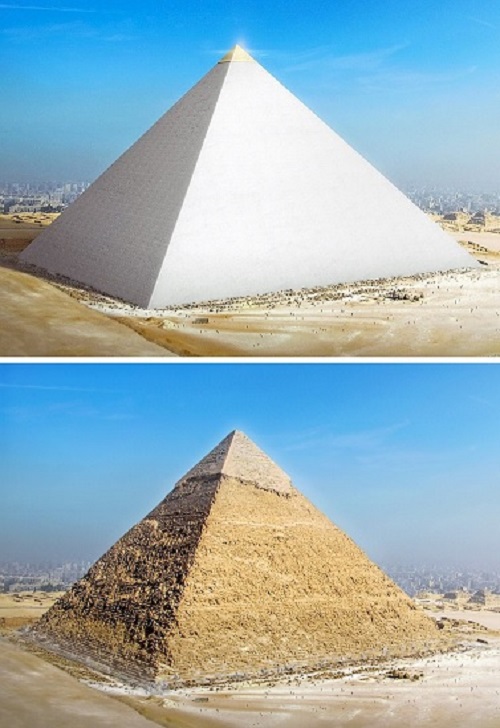The Great Pyramid Of Giza
Encodes The Speed Of Light At Least Six Different Ways
by Mark R. Elsis
“Egyptian civilization was not a development, it was a legacy.”
John Anthony West
1) The Latitude Of The Great Pyramid Of Giza
The latitude at the center of the Grand Gallery inside the Great Pyramid is 29 degrees 58 minutes 45.28 seconds North. This equals 29.9792458 degrees North. The speed of light in a vacuum is 299,792,458 meters per second. These are precisely the same numbers. John Charles Webb Jr. first discovered this, to see for yourself click the link: Degrees, Minutes, Seconds To Decimal Degrees Conversion. Of course, this is not a coincidence, as some sold-out, dim-witted fools would try and have you believe.
The mathematical probability that the building of the Great Pyramid was on purpose at the latitude representing the speed of light is 99.97%. There is only a 1 to 3,460 chance it is a coincidental match. A 99.7% chance and this excellent evaluation did not even account for any corroborating evidence supporting this astounding achievement.
If one takes the continental drift into account, perhaps when built, the latitude was dead center on the Great Pyramid and not 11 meters south, at the center of the Grand Gallery. This is not a far-fetched idea. Scientists say the African Nubian tectonic plate seems to be moving at about 0.2 inches per year to the north, and 11 meters equals 433 inches, so 4,600 years x 0.2 inches per year, equals 920 inches, which is 23.368 meters. If over the last 4,600 years, the African Nubian tectonic plate moved at just half that speed, 0.1 inches per year, it would be dead center on the Great Pyramid.
If the building of the Great Pyramid (also known as the Pyramid of Khufu or the Pyramid of Cheops) took twenty years, and was completed in 2,560 BC, as we have been told ad nauseam by the censorious academic orthodoxy and unscrupulous Egyptologists, how did the Egyptians know the extremely significant knowledge of constructing it on the latitude, which equals the speed of light?
As a side note, these so-called experts are the same insidious group of simpletons who would have you believe that the Great Pyramid was the tomb of Fourth Dynasty pharaoh Khufu. Yet not a single piece of evidence has ever been found to suggest the Great Pyramid was intended to serve as a tomb. In fact, researchers have never discovered any hieroglyphics or ancient text that links the Great Pyramid to a tomb.
If the Great Pyramid was complete in 2,560 BC, and the latitude encodes the exact speed of light in meters, one would assume that the ancient Egyptians measured distances in meters. But the meter did not become the official standard of measurement until 1799.
The units of measure used to construct the Great Pyramid were the Royal Cubit and the Pyramid Inch. From an overwhelming amount of significant evidence, one can deduce these units of measurement are geodetic. That is to say, having some specific relationship with the physical dimensions of Earth.
Professor Flinders Petrie, regarded as the founder of Egyptology and who studied the temples and buildings of ancient Egypt, measured the Great Pyramid with the utmost exactitude in 1880. From these measurements, he assigned a value for the Royal Cubit of 20.632 +/- .004 Imperial British Inches. This calculation was based primarily on the dimensions he found within the King’s Chamber in the Great Pyramid. Furthermore, at the time of Professor Petrie’s measurements in 1880, the British Inches had an equivalency of 2.53999779 centimeters.
The Pyramids And Temples Of Gizeh (Publication Date 1883)
by Sir William Matthew Flinders Petrie
https://archive.org/details/cu31924012038927
Sir Isaac Newton first suggested the Pyramid Inch as a common denominator in the construction dimensions within the Great Pyramid. In the review of the dimensions of the King’s Chamber, he ascribed a value of 20.63 British Inches for the Royal Cubit. It should be noted that 1.0011 British Inches constitute 1 Pyramid Inch.
Various sources have begrudgingly conceded the number 43,200 multiplied by some measurements of the Great Pyramid does arrive at the size of the Earth within a reasonable approximation. However, it has been well-established that the number 43,200 selection was purposeful to convey a highly accurate knowledge of the Earth. It also should be noted that 43,200 x 2 = 86,400, which is the number of seconds in one solar day.
Because of this and numerous other Great Pyramid measurements calculated in seconds, you would have to accept the ancient Egyptians measured time in seconds. Some ancient civilizations constructed divisions in the day, but not one used the term second, and none was a precursor to the modern second.
The Greco-Egyptian mathematician Claudius Ptolemy in his work “Almagest” first described the international unit of the second around 150 AD. He defined the second, or second-minute, as one-sixtieth of a minute. The second was not used in timekeeping, however, until the development in the 17th century of the first mechanical clocks that could track this unit of time. Marin Mersenne, a French mathematician, developed a pendulum clock that could track one second via the pendulum’s swing. The development of the atomic clock in the mid-twentieth century supplanted these early timekeeping devices, and the second was redefined in 1967 to mean the span of time for a cesium atom to undergo 9,192,631,770 energy transitions.
One would also have to suppose the ancient Egyptians knew the Earth was a globe, the location of the equator, and that they divided the latitude by 180 degrees. Yet, the Greeks didn’t discover the knowledge that the Earth was a globe until more than two thousand years later. The same goes for the golden ratio (Phi = 1.61803), the first known mention of the golden ratio is from around 300 BC in “Euclid’s Elements”, the classical Greek work on mathematics and geometry.
You would further have to infer the ancient Egyptians knew about the precession of the equinoxes, Pi (3.14159), had advanced and extensive knowledge of geodesy, astronomy, and mathematics, and also had the qualifications to understand a considerable amount of other exceedingly complex scientific and technological capabilities not yet invented.
So, how did the Egyptians know all of this incredible information in 2,560 BC?
The Great Pyramid’s faces are slightly indented (eight-sided), most visible here as a crease down the mid-line of the right face. The geometry simultaneously encodes the mathematics of both Pi and Phi and highlights various relationships between them. The center of the pyramid’s base lies just 11 meters south of the exact speed of light latitude, indicated here by the red dot, and challenging the history of science.
'If one is to send a
message the prime requirement is of course that people will read it,
it is no good putting it in a bottle, throwing it in the ocean and
then hoping it will be found. One must place the message somewhere
where it simply cannot be missed,
a place so significant that
its very location makes a notable statement in itself'.
John Tatler
2) The Height Of The Great Pyramid Of Giza, Minus The Height Of The Capstone
The Great Pyramid of Giza is the last of the Seven Wonders of the ancient world, the defining symbol of Egypt, and the most famous and discussed structure in history. It is the largest single building ever constructed and is a wonder mainly because of its scale and also because of the incredible precision with which the work was executed.
The height of the Great Pyramid, minus the height of the capstone, represents one-millionth of the time it takes for light to travel the mean radius of the earth's orbit around the sun (one astronomical unit or AU) using 1 Pyramid Inch equals 24 hours (mean solar day). [(5,813.2355653 (height of the Great Pyramid) - 103.0369176 (height of the capstone) / 10^6 = .0057101986 x 86,400 (seconds in a day) = 493.36116 seconds = 8 minutes, 13.36 seconds]
With the distance of one AU known and the transit time of light for this same distance, the velocity of light can be found. [91,848,816.9 miles / 493.36+ seconds = 186,169.5 miles per second]. This measurement equals 99.999% of the speed of light. The speed of light traveling through a vacuum is 186,282.4 miles per second.
“The conclusion that the Egyptians of the Old Kingdom were acquainted with both the Fibonacci series and the Golden Section, says Stecchini, is so startling in relation to current assumptions about the level of Egyptian mathematics that it could hardly have been accepted on the basis of Herodotus' statement alone, or on the fact that the Phi [golden] proportion happens to be incorporated in the Great Pyramid. But the many measurements made by Professor Jean Philippe Lauer, says Stecchini, definitely prove the occurrence of the Golden Section throughout the architecture of the Old Kingdom.... Schwaller de Lubicz also found graphic evidence that the pharonic Egyptians had worked out a direct relation between pi and phi in that Pi = Phi^2 x 6/5.”
Peter Tompkins
3) The King's Chamber In Its Relation To The Pavement Level Surrounding The Base Of The Great Pyramid Of Giza

Great
Pyramid Internal Features
Next we will look at the elevation of the King’s Chamber in its relation to the pavement level surrounding the base of the Great Pyramid. The level of the passage that leads to the King’s Chamber has an elevation of 1692 British Inches or (1690.14 Pyramid Inches) above the pavement level. This elevation was not randomly chosen, but rather, it’s a fundamental element of the design criterion.
If you multiply 1690.14 Pyramid Inches times the Code Number of the Queen’s Chamber, which is 2400, you arrive at a value of 4,056,336. When you multiply this value by the height of the Pyramid, which was calculated to have been 5813.0229 Pyramid Inches (36524.3/2), you arrive at 2.3579574 x 1010 Pyramid Inches. If you multiply this figure by the scale of the Great Pyramid to the Earth, which is 43,200, you arrive at 1.0186376 x 1015 Pyramid Inches, which equates to 2.5901833 x 1010 kilometers. The distance light travels in a vacuum or space in a period of one day is equal to 2.590206837 x 1010 kilometers. If you divide the figure as given by the Pyramid's dimensions, which is 2.5901833 x 1010 kilometers by 86,400 (seconds per day), you arrive at 299,789.7 kilometers. The accepted value for the speed of light in a vacuum is 299,792.458 kilometers per second. The speed of light in air is notably slower.
The calculation based on the elevation of the floor level leading into the King's Chamber amounts to an accuracy of 99.999% of the speed of light. If the passage elevation were merely higher by .0154 British Inches or 0.39 millimeters, the calculation would be 100% accurate. Perhaps over the many thousands of years, it settled by this amount, which would account for it being slightly lower.
The Giza Plateau lies exactly at both the intersection of the world’s lengthiest great circle (13,642 kilometers) and the world’s lengthiest parallel over land (12,734 kilometers).
“The Great Pyramid was a fractal resonator for the entire Earth. It is designed according to the proportions of the cosmic temple, the natural pattern that blends the two fundamental principles of creation. The pyramid has golden ratio, Pi, the base of natural logarithms, the precise length of the year and the dimensions of the Earth built into its geometry. It demonstrates . . . As John Michell has pointed out in his wonderful little book, City of Revelation, 'Above all, the Great Pyramid is a monument to the art of 'squaring the circle''.”
Alison Charlotte Primrose
4) Circumference Of The Inside Circle Subtracted From The Circumference Of The Outside Circle Of The Great Pyramid Of Giza
When a circle is drawn through the four points of the outside base (1,023.459 meters) of the Great Pyramid and another is drawn touching the corners on the inside base (723.6951 meters) of the Great Pyramid, and then subtract the circumference of the inside circle from the outside circle you get 299.7639 meters x 1,000,000 = 299,763,900. The speed of light is 299,792,458 meters per second. This measurement equals 99.99% of the speed of light.
"The Golden Ratio defines the squaring of a circle. Stated in mathematical terms, this says: Given a square of known perimeter, create a circle of equal circumference. According to some [for those with eyes to see], in ancient Egypt, this mathematical mystery was encoded in the measurements of the Great Pyramid of Giza."
Marja De Vries
5) The Elevation Of The Horizontal Passage Leading Into The Subterranean Chamber Inside Of The Great Pyramid Of Giza
There is yet another part of the Great Pyramid which much consideration should be given, and that's the elevation of the Horizontal Passage leading into the Subterranean Chamber. The elevation of the floor of this passage below the pavement level surrounding the Great Pyramid is 1181 + - 1 British Inch, as measured by Professor Flinders Petrie.
Converted to metric, this is equivalent to 2,999.7 centimeters + - 2.54 centimeters. Multiply this value by 10,000,000 and one arrives at a distance of 299,970 kilometers + -254 kilometers. It is conceivable, thereby, that the elevation of the Subterranean Passage Floor, was purposefully designed to be equivalent to the distance light travels in 1 /10 Millionth of a second to within an accuracy of 99.94%. + - .08%.
“As I explain at some length in 'The Crystal Sun' this particular angle, which we can call the 'golden angle,' is the precise value of the acute angle of a right-angled 'golden triangle' that embodies the golden mean proportion . . . The Danish art historian Else Kielland established with conclusive and absolutely overwhelming evidence and analysis that this angle was the basis for all Egyptian art and architecture. She did this in her monumental work 'Geometry in Egyptian Art' . . . The King's Chamber inside the Great Pyramid embodies no fewer than eight occurrences of the golden angle, and the coffer in the chamber embodies yet more.”
Robert K.G. Temple
6) The Angle of The Of The Great Pyramid Of Giza
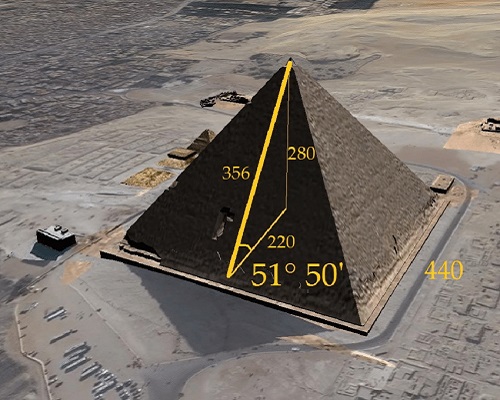
Perhaps
the first intriguing aspect one discovers about the Great Pyramid is
that it is perfectly oriented to the four points of the compass, only
being out by 3-arc minutes, a discrepancy of less than 0.06%, and is
based not on magnetic north but true north, which has staggering
implications for the level of knowledge, scientific and technical
understanding of the builders. Supposedly, the most accurate
north-oriented structure we have built in modern times is the Paris
Observatory, but even this is 6-arc minutes off from true north. Like
a gigantic sundial, the sharply pointed shadows cast by the Great
Pyramid from the sun's position in the sky will naturally mark the
annual dates of the summer and winter Solstices and the vernal
(spring) and autumnal Equinoxes.
The angle of the Great Pyramid of Giza is 51 degrees, 50 minutes, 4 seconds. This equals 186,664 seconds of the compass (a 360-degree protractor = 1,296,000 seconds). The speed of light in miles per second is 186,282.4. This angle measurement is 100.20% of the speed of light in miles per second.
“Central to all these interlinked themes was that curious irrational, Phi, and the Golden Section. Schwaller de Lubicz believed that if ancient Egypt possessed knowledge of ultimate causes, that knowledge would be written into their temples not in explicit texts but in harmony, proportion, myth and symbol.”
John Anthony West
Also Of Importance:
The Speed Of Light And The Fine Structure Constant Of The Giza Plateau And Sphinx
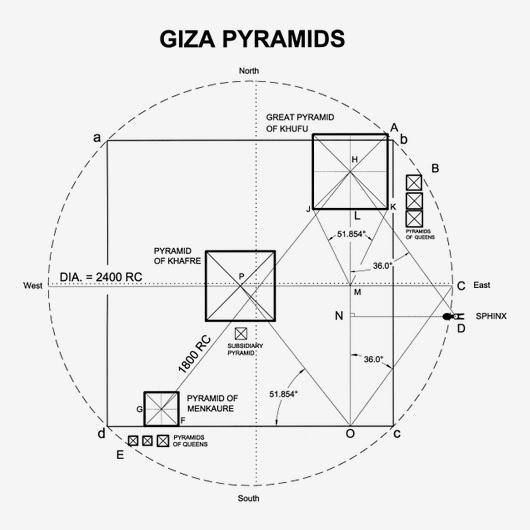
On the Giza plateau there are three principal Pyramids; The
Great Pyramid of Khufu, also known as Cheops, The Pyramid of Khafre
(The Son of Khufu) and the Pyramid of Menkaure (The Grand-son of
Khufu). In addition to these three principal pyramids there are 3
relatively small pyramids to the East of The Great Pyramid of Khufu
as well as 3 small pyramids to the south of The Pyramid of Menkaure.
These pyramids have been named " Pyramids of Queen's".
Additionally, there is a small Subsidiary Pyramid to the south of The
Pyramid of Khafre. The Sphinx is located East of the Pyramid of
Khafre, slightly to the north of the East End of a Causeway
originating at the Mortuary Temple of Khafre which is, itself,
located at the East Side base of The Pyramid of Khafre. To the South
of the Sphinx is the Tomb of Queen of Khafre and to the East lies the
Sphinx Temple and South-East, The Valley Temple of Khafre. Other
features of the Giza Plateau are a Mortuary Temple at the East Side
Base of the Pyramid of Menkaure wherefrom another Causeway leads to
the Valley Temple of Menkaure. Note that the North East corner of the
Great Pyramid of Khufu intersects the 2400 Royal Cubit diameter
Circle at point A on the drawing. Furthermore, The North-East Corner
of the northern most Pyramids of Queens of the Great Pyramid of Khufu
intersects the circle at point B. Also, we may appreciate that the
South West corner of the western-most Pyramids of Queens of The
Pyramid of Menkaure intersects this circle at point E on the drawing.
These points all intersect the Circumference of a Circle which has a
Diameter of exactly 2400 Royal Cubits. Very significantly, it is also
found that the Sphinx itself lies on the circumference of this 2400
Royal Cubit diameter circle. Furthermore, we see that the southern
edge of The Pyramid of Menkaure sits on the southern boundary of the
inscribed square that is formed within the 2400 Royal Cubit Diameter
Circle.
by Eckhart R.
Schmitz
http://thegreatpyramidofgiza.ca/content/index.html#the-symmetry-of-the-giza-plateau
What’s extremely interesting is the distances between the Sphinx and the apex centers of all three subsidiary pyramids of Queens adjacent to Khufu (Great Pyramid). Between Khufu c and the crown-head-center of the Sphinx is a distance of 1,080 meters. Between Khufu b and the crown-head-center of the Sphinx is a distance of 1,040 meters. Between Khufu a, and the crown-head-center of the Sphinx is a distance of 993.7639 meters.
Add these three distances together:
1,080 + 1,040 + 993.7639 = 3,113.7639.
From the result, we then subtract 2,160 meters:
3,113.7639 – 2,160 = 953.7639.
We then divide 512 from the result:
953.7639 / 512 = 1.8628201171875.
The first six digits of this result just happen to be the miles per second speed of light in a vacuum figure 186,282 divided by 100,000.
Furthermore, 1.8628201171875 divided by 256 = 0.007276641082763 - the first five digits of which are the first five digits in the number given to the Fine-Structure Constant – the most mysterious number known in physics . . . 0.007297352566355, which is the result of 1 ÷ 137.035999139.
In fact, if we take just the numbers in the latitude coordinates of the crown-head-center of the Sphinx, (29.975295), multiply these numbers by 256, and then divide the number 56 by the result, we get an even closer value for fine-structure constant at six decimal places . . . 29.975295 x 256 = 7,673.67552. 56 ÷ 7,673.67552 = 0.0072976763 . . . an accuracy of 99.996%.
“Every chamber within the pyramid has a specific harmonic replicating the harmonics of the cavities of the human body. Sound healing techniques were then used to restore the patient’s body to the correct harmonics.”
Abd’el Hakim Awyan
Queen's Chamber Relationship To Te Base Perimeter Of The Great Pyramid
An interesting mathematical relationship may be found in regard to the Queen’s Chamber and the Base Perimeter of the Great Pyramid, which is as follows. In order to arrive at this relationship one must first determine the cubic volume of the Queen’s Chamber and for this purpose we may view the schematic drawing as follows:
The volume may be calculated as follows:
Width x Length x Height (of the cubic rectangle)
205.85 x 226.47 x 184.47 = 8,599,779 Cubic British Inches
Thereto one adds the volume of the Triangular Apex
½ x 205.85 x 60.63 x 226.47 = 1,413,250.4 Cubic British Inches
Therefore the total volume of the Queen’s Chamber is as follows:
8,599,779 + 1,413,250.4 = 10,013,029.40 Cubic British Inches
In order to determine the cubic Pyramid Inches one divides:
10,013,029.40 / 1.00113 = 9,980,059 Cubic Pyramid Inches
And furthermore, to determine the volume in Cubic Royal Cubits one divides:
9,980,059 / 20.606629643 = 1140.54 Cubic Royal Cubits
Therefore the Queen’s Chamber has an interior volume of 1140.54 Cubic Royal Cubits.
If we divide the value of 1140.54 Cubic Royal Cubits by 1,000,000 (10002) we arrive at a value of .00114054 .
Consideration should be given that the Great Pyramid relates to a Hemi-Sphere, that is to say half a sphere, therefore, one may multiply the value of .00114054 times 2 arriving at a value of .00228108. It is to be given consideration that this final value should be taken simply as a numerical value and not as a specific volume. In other words what is important is the number in and of itself. We shall see this logic throughout the Pyramid’s measurements. As stated, if we multiply the base circumference of the Great Pyramid by 43,200 we arrive at the measure of 40,121.434 kilometers as we have already seen. Now if we divide 40,121.434 kilometers by (1 + .00228108) we arrive at a measure of 40,030.122 kilometers for which the radius of this circumference is 6,370.9918 kilometers. It is of considerable interest to note that the Harmonic Mean Radius of the Earth is 6,370.9928 kilometers, which is a difference of .001 kilometers or 1 meter. If this Equation involving the Queen’s Chamber and the Base Circumference was purely by chance it would be extraordinary, however, we shall see further relationships, which will compliment this finding and will verify that the size and shape of the Earth was known to an exceptional degree of accuracy.
The following is the calculation to determine the Harmonic Mean Radius of the Earth:
Harmonic Mean Radius of the Earth = 3ab/(a+2b)
a = Semi-Major Axis (Equatorial Radius) = 6378.137 km
b = Semi-Minor Axis (Polar Radius) = 6356.7523 km
by Eckhart R. Schmitz
http://thegreatpyramidofgiza.ca/content/index.html#queens-chamber-relationship-to-pyramid-base
“As electrical energy can create mechanical vibrations (perceived as sound by the human ear), so in turn can mechanical vibrations create electrical energy, such as the previously mentioned ball lightning. It could be theorized, therefore, that with the Earth being a source for mechanical vibration, or sound, and the vibrations being of a usable amplitude and frequency, then the Earth's vibrations could be a source of energy that we could tap into. Moreover, if we were to discover that a structure with a certain shape, such as a pyramid, was able to effectively act as a resonator for the vibrations coming from within the Earth, then we would have a reliable and inexpensive source of energy.”
Christopher Dunn
The Giza Plateau
So, I ask again, how did the Egyptians know this extremely complicated mathematics and advanced knowledge of the earth and astronomy some 4,560 years ago? That is, if one believes the Great Pyramid and the Giza plateau date back to when almost all Egyptologists say, and not much earlier as the late John Anthony West and Robert M. Schoch proved with their Sphinx water erosion hypothesis.
John Anthony West also asserted that he thought the Great Pyramid, Sphinx, and the Giza plateau were all built much, much earlier.
As Robert Bauval States: “In the beliefs of the Egyptians the King was the earthly representation of this God (Horakhti), and we have proof that in the very early period the dead King especially was called Horakhti. When Khafra cut the Great Sphinx, it was made in his likeness, that is to say in the likeness of Hor-akhty, with whom he was identified.”
These two names, Horemakhet and Horakhti, have a very similar rendition. Horemakhet meaning ‘Horus in the Horizon’, and Horakhti meaning ‘Horus of the two Horizons’. There is no doubt, however, that the name Horemakhet was exclusively used for the Great Sphinx of Giza, whereas the name Horakhti was used for a figure in the eastern horizon which I have identified to the zodiacal constellation of Leo and which was also idetified with the Great Sphinx.
If this is the case, then there is a problem with allocating the Great Sphinx to Khafre, a king of the IVth Dynasty who reigned in 2,500 BC is this: the Great Sphinx is gazing directly due east, whereas the constellation of Leo/Horakhti rose at that time some 28 degrees north of due east. The correct epoch for the Great Sphinx to gaze at his own image would be 10,500 BC.
http://myblog.robertbauval.co.uk/2014/12/22/the-age-of-leo
This occurred because of the precession of the equinoxes (Great Year), which is an observable phenomena of the rotation of the heavens, a cycle which spans a period of approximately 25,770 years, over which time the constellations appear to slowly rotate around the earth. It is this Precession of the axis that causes the change in the Constellation alignment at the Vernal Equinox (Spring Equinox in northern Hemisphere) that defines an Era.
For instance, we are presently in the Age of Pisces and are moving into the Age of Aquarius. Each Age is 1/12 of the Great Year, about 2,160 years. A period of 25,920 years is often suggested as it conveniently relates to a Precession rate of 1 degree in 72 years (72 x 360 = 25,920) and an Age of 30 degrees in 2,160 years (2,160 x 12 = 25,920). Precession of the equinoxes is what Plato referred to as the “great year”.
John Anthony West stated that there is a King’s List in Egypt that dates back almost 40,000 years, and he thought that the Great Pyramid, Sphinx, and the Giza plateau, were built one precession earlier than what Bauvel discovered about the Great Sphinx facing the constellation of Leo 12,500 years ago. Meaning, 25,920 years plus 12,500 years, or approximately 38,420 years ago.
“The Sabians were allowed to build a new Temple of the Moon God, and to continue their religious rites, after the Arab General Ibn Ghanam conquered Harran in the seventh century AD. This in itself is a sign of most unusual favor, since Islamic armies normally offered "pagans" the choice of either conversion or death. Even more interesting, however, is the Sabians' encounter with the Abbasid Caliph Abu Jafar Abdullah al-Ma'mun, who passed through their city in AD 830 and reportedly quizzed them intensively on their religion. Remembering the Sabian pilgrimages to Giza, it is reasonable to wonder whether there is any connection with the fact that in AD 820, a decade before he visited Harran, it was Ma'mun who tunnelled into the Great Pyramid and opened its previously hidden passageways and chambers. Indeed, it is through "Ma'mun's Hole" that visitors still enter the monument today. Described by Gibbon as "a prince of rare learning," it seems Ma'mun's investigation was prompted by information he'd received about the Great Pyramid, specifically that it contained: 'a secret chamber with maps and tables of the celestial and terrestrial spheres. Although they were said to have been made in the remote past, they were suppposed to be of great accuracy.”
Graham Hancock
The Great Sphinx Of Egypt At Giza
From Robert M. Schoch: Many people know me best for my work on the Great Sphinx of Giza, Egypt. The Great Sphinx sits near the Great Pyramid on the western bank of the Nile, outside of modern Cairo. According to standard Egyptological thinking, the Great Sphinx was carved from the limestone bedrock on the orders of the Old Kingdom Pharaoh Khafre around 2500 BC.
In 1990 I first traveled to Egypt with John Anthony West (for background information see Forgotten Civilization and Origins of the Sphinx), with the sole purpose of examining the Great Sphinx from a geological perspective. I assumed that the Egyptologists were correct in their dating, but soon I discovered that the geological evidence was not compatible with what the Egyptologists were saying. On the body of the Sphinx, and on the walls of the Sphinx Enclosure (the pit or hollow remaining after the Sphinx’s body was carved from the bedrock), I found heavy erosional features that I concluded could only have been caused by rainfall and water runoff.
The thing is, the Sphinx sits on the edge of the Sahara Desert and the region has been quite arid for the last 5000 years. Furthermore, various structures securely dated to the Old Kingdom show only erosion that was caused by wind and sand (very distinct from the water erosion). To make a long story short, I came to the conclusion that the oldest portions of the Great Sphinx, what I refer to as the core-body, must date back to an earlier period (at least 5000 BC, and my latest research now points to the end of the last ice age, circa 10,000 BC), a time when the climate was very different and included more rain.
by Robert M. Schoch
https://www.robertschoch.com/sphinx.html
In
his book Voyages of the Pyramid Builders, Boston University geology
professor Robert M. Schoch details key anomalies in both radiocarbon
studies; most notably that samples taken in 1984 from the upper
courses of the Great Pyramid gave upper dates of 3809 BC (± 160
years), nearly 1400 years before the time of Khufu, while the lower
courses provided dates ranging from 3090-2723 BC (± 100-400 years)
which correspond much more closely to the time Khufu is believed to
have reigned. Given that the data imply the pyramid was built
(impossibly) from the top down, Dr. Schoch argues that if the
information provided by the study is correct, it makes sense if it is
assumed the pyramid was built and rebuilt in several stages
suggesting later Pharaohs such as Khufu were only inheritors of an
existing monument, not the original builders, and merely rebuilt or
repaired previously constructed sections.
John Anthony West
John Anthony West delivered a seismic shock to archaeology in the early 1990s when he and Boston University geologist Dr. Robert Schoch revealed that the Great Sphinx of Giza in Egypt, showed evidence of rainfall erosion. Such erosion could only mean that the Sphinx was carved during or before the rains that marked the transition of northern Africa from the last Ice Age to the present interglacial epoch, a transition that occurred in the millennia from 10,000 BC to 5,000 BC.
Archeologist dismissed this new idea saying that people back then were hunter-gathers, and that there wasn’t any archeological proof of megalithic structures older than at the Giza Plateau or Stonehenge. This idea was turned on its head when Göbekli Tepe was discovered, excavated and found to be about 12,900 years old.
In 1994, German archaeologist Klaus Schmidt, who had previously been working at Nevali Çori, was looking for another site to excavate. He reviewed the archaeological literature on the surrounding area, found the 1963 Chicago researchers' brief description of Göbekli Tepe, and decided to reexamine the site. Having found similar structures at Nevali Çori, he recognized the possibility that the rocks and slabs were prehistoric. He began excavations the following year and soon unearthed the first of the huge T-shaped pillars. Schmidt continued to direct excavations at the site on behalf of the Sanliurfa Museum and the German Archaeological Institute (DAI) until his death in 2014. Since then, the DAI's research at the site has been coordinated by Lee Clare. Recent excavations have been more limited than Schmidt's, focusing on detailed documentation and conservation of the areas already exposed.
Göbekli Tepe: Who Built It,
When And Why
These are the questions I ask in new book Göbekli Tepe: Genesis of the Gods, in which I provide compelling evidence that the myths of the Watchers of the book of Enoch and the Anunnaki of Mesopotamian myth and legend are memories of the Göbekli builders and their impact on the rise of civilization. Using this guise the shaman could enter the sky world and counter the actions of the supernatural creature seen as responsible for cataclysms like the comet impact of 10,900 BC, referred to by scientists today as the Younger Dryas Boundary event.
by Andrew Collins
https://grahamhancock.com/collinsa3
Gobekli
Tepe Is Rewriting Our Entire Understanding Of Human History
Gobekli Tepe has made lots of people scratch their heads. Even though it was uncovered during the ‘60s, it’s significant impact was just fully realized in 1994. This historical site is situated in the southeastern part of Turkey, approximately 12 kilometers northeast of the city of Sanliurfa. Despite this, it predates the country’s establishment by a huge margin. This archaeological site has existed for so long that it rewrites people’s understanding of not just the history of Turkey but also the history of mankind. If we base facts on previous knowledge about how modern civilization started then Gobekli Tepe must not be there. However, this place truly exists and has been around for almost 12,000 years.
by Michael Peres
https://thriveglobal.com/stories/gobekli-tepe-is-rewriting-our-entire-understanding-of-human-history
Gobekli Tepe: The Other Hill Of Osiris
A re-examination of the site reveals an Egyptian connection and an astronomical alignment to Vega and Orion.
Portasar’s most fascinating stone circle is Enclosure D. Its organic material has been carbon-dated to 10,500 BC 1 suggesting people were present here three hundred years after the meteorite strike that triggered the Younger Dryas epoch. By the same token, C-14 dating of the wall mortar protecting this enclosure offers a range of 9990-9600 BC, suggesting activity at the site one hundred years either side of the meteor strike that generated the great flood and the end of the Younger Dryas. It would appear that someone came to this hill in Anatolia to construct what appears to be an observatory or a library in stone, then carefully packed up the site and left prior to the destruction about to unfold.
by Freddy Silva
https://invisibletemple.com/extra/gobekli-tepe-hill-of-osiris-astronomical-alignment-vega.html
Yet the exceedingly stubborn archeologists still suggest the Great Sphinx was created by ancient Egyptians of the Old Kingdom during the reign of Khafre, son of Khufu, between 2558 and 2532 BC.
“No machines have been found in
the archaeological record to support these assertions, but there is
an abundance of circumstantial evidence that leads to such
conclusions. Are the machines still intact and lying under the desert
sand? Or were they removed completely from the areas? Or could it be
that all this evidence points to an earlier civilization that
suffered a cataclysm of such magnitude that much of what existed was
destroyed, and what remained was susceptible to erosion, decay, and
corrosion, and slowly disappeared over a long period of time? This
brings us back to Robert Schoch's evaluation of the erosion pattern
on the Sphinx and the Sphinx enclosure. He claimed that the period of
time when sufficient rain fell in Egypt to cause this erosion was
seven to nine thousand years ago. Is this sufficient time for ancient
machines to turn to dust and blow away? It seems incredible to
imagine, but there is reason to suspect that this could have happened
. . . If we follow the idea of an older civilization, therefore, the
pyramids would have already been there before the first dynasty of
the ancient Egyptians. The Great Pyramid was, most likely, the zenith
of construction on the plateau, and the other pyramids were likely
built before it was. Yet something happened to the culture that built
the pyramids, and when Khufu came on the scene, he naturally chose
the most impressive structure--the Great Pyramid--as his own, and his
heirs took turns in claiming the rest. What event could have brought
death and destruction to this ancient civilization that is referred
to in Egyptian lore as being inhabited by gods of the First
Time?”
Christopher Dunn
The Great Pyramid Of
Giza Is The Only Known Eight-Sided Pyramid In Existence
In the Great Pyramid the packing-blocks were laid in such a way that they sloped ever so slightly inwards towards the center of each course, with a result that a noticeable depression runs down the middle of each face - a peculiarity shared, as far as is known, by no other pyramid.
In fact, to spot this strange characteristic, you need to travel above the pyramid, at either dawn or sunset on the spring and autumn equinoxes, when the sun casts shadows on the pyramid.
The phenomenon was spotted for the first time in 1940 by accident as British Air Force pilot, P. Groves, was flying over the pyramid and noticed the concavity on the Pyramid, and decided to take a picture of what he had observed.
https://curiosmos.com/the-great-pyramid-of-giza-is-the-only-known-eight-sided-pyramid-in-existence
Photograph by P. Groves 1940
The Giza Pyramids As A Stellar
Representation Of Orion's Belt
“Controversial as
this may at first seem, we have also seen how, when the sky is
precessed to 11,451 BC and the three stars of Orion are aligned along
the meridian with the three pyramids of Giza, the image of Zep Tepi
in the sky (the triangular region of Orion-Pleiades-Leo) bears an
uncanny resemblance to the image of zep tepi on the ground (the
triangular region of Giza-Memphis-Heliopolis).”
Robert Bauval
Left: Giza Pyramids
Right: Orion’s Belt
Now let’s look at two other pictures. One of the Giza Pyramids and the other of Orion’s belt (taken by Lowell Observatory). We can see a possible intention by the pyramid builders to represent Orion’s belt with pyramids. But was there such intention?
The first questions that come to mind in order to demonstrate such possible intention are these:
Did the pyramid builders have a keen interest in the stars? Yes they did.
Do the pyramids have astronomical qualities in their design? Yes they do.
Is there a feature in the pyramids that links them to Orion’s belt? Yes there is (the southern shaft from the King’s Chamber in the Great Pyramid).
Are there contemporary or near-contemporary texts, which are associated to pyramids in that region and which speak of a link with Orion? Yes, there are.
Did the ancient Egyptians imagine the pyramids to be ‘stars’? Yes (the Zawyat al Aryan pyramid was called ‘The Pyramid of Nebka is a star” and the Abu Ruwash pyramid was called “The Pyramid of Djedefre is a Sehed Star”. Also the ‘soul’ (Ba) in ancient Egypt was equated to a ‘star’, and several pyramids bear ‘soul names’, such as “The Pyramid of Neferirkare has become a Ba (Soul)” and “The Ba (Soul) of Sahure Gleams”.
From the above we must conclude that there is much that suggests a deliberate intention to represent Orion’s belt at Giza.
by Robert Bauval
https://grahamhancock.com/pyramids-orion-bauval
The
Egypt Code: The Mystery Of 10,500 BC
In Robert Bauval’s 2008 book The Egypt Code, in his typical meticulously researched style has sets out to prove the theory that the ancient Egyptians built their pyramids on the Memphite Necropolis not in a random haphazard fashion, but to reflect the cosmos in order to unite Heaven and Earth. Here I will present the core ideas and evidence from Robert Bauval’s book The Egypt Code that validate the existence of a high civilization that existed on this Earth around 12,000 years ago. This is important because for one, it is essential that we understand the truth of our history and the truth of human origins.
by Brandon West
https://humansbefree.com/2015/01/the-egypt-code-the-mystery-of-10500-bce.html
The Giza Oracle: A New Theory Concerning The Design Of The Pyramids Of Giza
It is possible then, on the basis of this, that in a time before the Babylonians, someone, somewhere may have had the beginnings of our present zodiac – a zodiac that perhaps did include the Age of Leo, symbolised as a lion. Lost knowledge of a `lost civilisation’ perhaps?
Accepting this as a possibility the twelve signs of the zodiac are placed around the precession wheel to create a ‘precession clock’. The starting point or calibrating point for the wheel is, of course, the Great Sphinx and this possibly explains why it sits outside the circle – its realm is in the cosmos and the wheel is symbolic of the precessional turning of the stars. The date the clock is calibrated to the dawn (symbolised by the Great Sphinx facing east where dawn rises) of the previous Age of Leo (the Sphinx symbolises a lion) which occurred around the year 10,948 BC.
It is unlikely, however, that the ancient Designers of the Giza Precession Wheel would have left us to guess precisely what year they used as the start point for their astronomical clock and would have found a way to tell future civilisations the precise date to use as the start date – i.e. the year, relative to our own time-frame, the Designers' recognised as the 'Dawn of Leo'. This date will, in all likelihood, differ to the date our modern calendar recognises as the previous Dawn of Leo. It barely needs to be said but this start date or 'Year 0' is crucial to determine the dates encoded into the Precession Wheel. And it would seem that this crucial date is provided for us through the Great Giza Triangle (GGT). Let us now see how.
In the design of the GGT (and indeed the 3 Great Pyramids themselves) we are immediately drawn to the 'misaligned pyramid' of Menakau-Ra. It is one of Giza's most enduring puzzles and we find ourselves asking (as Robert Bauval did) why should this small pyramid be off-centre? Certainly the Centroid Alignment Theory shows how it comes to be misaligned from a mathematical perspective but it does not explain why the Designer's would have chosen such a design technique to 'create' such a misalignment. What is it they are trying to show us with this misalignment? What truth, if any, lies in the maths?
Misalignment of Menkau-Ra is Due to 47 angle (from North) of the GGT Baseline.
Mathematically, the misaligned pyramid of Menkau-Ra (in the context of the Centroid Alignment Theory) is misaligned specifically due to the angle of the GGT baseline. Changing the angle of the GGT baseline has the effect of shifting the position of Menkau-Ra's centre point. The baseline and the centre point (or centroid) of Menkau-Ra are, therefore, inextricably linked. In other words – the Designers' have fixed the baseline of the GGT at a very specific angle – 47 degrees from true north – in order to achieve the very specific misalignment of Menkau-Ra.
So now, if we are to accept (as Bauval/Gilbert propose) that the misaligned pyramid of Menkau-Ra is symbolic of the misaligned star (Mintaka) in Orion's Belt, then what can possibly connect this star with the 47 degrees we find in the Great Giza Triangle's baseline? The answer is simple and logical – declination!
The constellation of Orion (as with most constellations) slowly changes its declination (i.e. drifts up and down) on the southern horizon over the course of the Great Year (Precession of the equinoxes). So, it is possible then that the fundamental purpose of the Great Giza Triangle is to provide us with a precise 'dating mechanism' for the astronomical clock based on the 'misaligned' star (Mintaka) with pyramid (Menkau-Ra). Let us take a moment to examine Mintaka's declination over the last 13,000 years.
Year Declination
2,007 AD -0.50
2,007 BC -11.90
5,000 BC -27.90
7,500 BC -40.50
10,000 BC -47.27
10,950 BC -47.00
Declination of Mintaka over the Ages.
Mintaka appears to have a declination of -47 in the year 10,950 BC. Intriguingly, this date shows a remarkable correlation with other ancient sources that place the Dawn of Leo circa 10,948 BC - a difference of only 2 years. We now have the start date (Year 0) of the Precession Wheel - 10,948 BC.
The Sphinx Represents the Dawn of the Previous Age of Leo (10,948BC) Map Source, Lehner - `The Complete Pyramids’.
It is a very simple calculation to convert the angle of these alignments into actual dates. Since we know that 1 degree of the Great Precession Year is equivalent to approximately 72 years, a simple multiplication yields the number of years for each angle:
Khufu alignment = 52° x 72 = 3,744 years + 10,948 (dawn of Leo) = 14,692 BC (16,692 BP)
Menkau-Ra Alignment = 116° * 72 = 8,352 years – 10,948 (dawn of Leo) = 2,596 BC (4,596 BP)
Intriguingly these 2 dates correspond with highly significant past events. It is a matter of scientific fact that around 16,000-17,000 years ago the end of the last ice age took place. The catalyst for this defining moment in the development of human civilisation still remains a mystery but it is perhaps possible that the ancient Designers allude to its cause within the Giza Precession Wheel.
The second date (the Menkau-Ra alignment) of 4,596 BP is equally significant since this seems to point directly to the era within which Egyptologists believe the Giza pyramids were finally completed.
The Giza Oracle indicates a number of other dates that have been plainly encoded into the wheel and demonstrates how these dates also correlate with significant events from our ancient past, in particular, the global extinction event that took place around 13,000 BP - a date that correlates almost perfectly with the Precession Wheel start year of 12,948 BP. But more than this, it seems that the ancient Designers of the wheel are perhaps indicating that the events of the past are actually part of a cycle, a cycle that could possibly see a return to the events of the past some time in our immediate future.
by Scott Creighton
https://grahamhancock.com/creightons1
“Like all other initiatic teaching, Egypt held that man's purpose on earth was the return to the source. There were recognised in Egypt two roads to this same goal. The one was the way of Osiris, who represented the cyclic nature of universal process; this was the way of successive reincarnations. The second road was the way of Horus, the direct path to resurrection that the individual might achieve within a single lifetime. It is the Horian way that is the basis of the Christian revelation and, according to Schwaller de Lubicz, the aim of Christianity was to make this direct path available to all who chose to embark upon it, rather than to a small group of select initiates who, in Egypt, comprised ‘The Temple’. In this sense, and in this sense only, has there been ‘evolution’ in human affairs.”
John Anthony West
The Great Pyramid Of Giza Internal Ramp by Jean-Pierre Houdin
Jean-Pierre Houdin is a French architect.
He
created the internal ramp theory detailing how the Great Pyramid of
Giza was built.
The Great Pyramid Of Giza
Internal Ramp by Jean-Pierre Houdin (52:17)
https://www.bitchute.com/video/bVzj5mFpyWfE
Jean-Pierre Houdin
https://www.youtube.com/channel/UCu4PL4y3eBfb6ZsEsrvGtmg
Khufu: The Secrets Behind the Building of the Great Pyramid
by Jean-Pierre Houdin
https://www.amazon.com/Khufu-Secrets-Behind-Building-Pyramid/dp/9771730614
Khufu's Internal Ramp Theory
Over eight years have now passed since Jean-Pierre Houdin and his devoted wife ‘Bulle Plexiglass’ (Michelle) fused their life’s equity into a passionate architectural affair with the Great Pyramid, located on the Giza Plateau in Egypt; “A ramp theory” - an internal one; enclosed; continually winding its way up to the apex of the Great Pyramid by means of turning 90 degrees corners; encasing workman hauling blocks of stones weighing tons; using rope, cranes, sleds, scaffolds and any other means by which a hefty stone could be maneuvered; builders hollaring and lots of sweat.
The energy to create such an internal ramp can be measured and defined if calculated in detail; Jean-Pierre has detailed his architectural renderings and has come up with some staggering factors. A modern high- tech French architect who had no previous yearnings of the Great Pyramid’s construction prior to his last decade of research has used his upscale mindset to configure how the Ancient Egyptian’s might have constructed their most magnanimous feat of monumental structures.
Jean-Pierre’s ability to create colorful graphics tends to lead the reader to view his internal ramp construction theory as a method to get his views across as opposed to reading and reasoning his renderings, calculations and thoughtful suggestions of e.g., “intercom systems” which he claims were built deep within the Great Pyramid’s Queen’s Chamber to accommodate the builders and crews.
by Jean-Pierre Houdin
http://www.robertschoch.net/Jean%20Pierre%20Houdin%20Egypt%20Pyramid%20Theory.htm
Return To The Giza Power Plant
The Amazing
Boxes Of The Serapeum
The Incredible Symmetry And Precision Of
The Rameses Statues
by Christopher Dunn
“Christopher Dunn makes a stunningly convincing case that the makers of the ancient Egyptian stone monuments and images possessed sophisticated technologies rivaling our own in terms of their precision and capabilities."
Michael A. Cremo
Return To The Giza Power Plant
The Giza Power Plant: Technologies Of Ancient Egypt was published in August 1998. Since then I have been overwhelmed by the response to the power plant theory. The reviews have been nothing short of incredible! I have received letters and emails from all over the world that support the argument that high levels of technology existed in prehistory on this planet and that the Great Pyramid represents the pinnacle of that technology.
Though the power plant theory may explain every characteristic and noted phenomena found within the Great Pyramid, without actually replicating its function (way beyond my own personal resources) it could be ignored or dismissed as being too fantastic by those who feel more secure with conventional views of prehistory. Not so with the hard evidence of machining! There is a section in the book that is increasingly being seen as the "smoking gun" which proves, beyond a shadow of a doubt, that the pyramid builders used advanced technology. It is not a simple matter to dismiss the physical constraints imposed on those who would attempt to accurately replicate the granite artifacts found in abundance all over this ancient land. Those who try to dismiss it do so from inexperience and do not understand the subtleties of the work, or they cling desperately to the belief that Western Civilization is the first civilization to develop science and translate that science into products that require advanced methods of manufacturing.
My article, Advanced Machining in Ancient Egypt has been under public scrutiny for around 15 years. (A shortened version appeared in Atlantis Rising #9 as An Engineer in Egypt, and a complete expanded version with the latest updates fills two chapters in the book.) With the level of support that it has received from those who, in modern times, would be charged with performing the same kind of work performed by the ancient Egyptians, along with additional proof, it is rising from the rank of theory to fact. Since its original publication in Analog magazine in 1984, this tentative, controversial thorn in the side of Egyptologists has been reinforced time and time again by my own on-site inspections and others who have had the opportunity to see these incredible artifacts for themselves. The weight of evidence and the educated opinions of those who understand this kind of work, are creating a consensus that is overturning our understanding of prehistory, with implications that are stunning.
The most awesome implication has to be that civilizations are mortal! Civilizations such as ours can rise to great heights and be dashed onto a path of devolution by natural or engineered effects. In a blink of an eye, we can lose it all! Whether as one or multiple blinks of an eye, our distant ancestors in prehistoric Egypt received a mortal blow to the industry that was capable of creating the artifacts we see there today. Whether that blow came from extraterrestrial forces such as a comet, geophysical disturbances, or even a nuclear war, are open to speculation, the fact remains that their industries did exist, and they somehow became extinct!
The purpose for this article is not to belabor the obvious or to restate what others have stated more eloquently, but to bring you an update on what has happened since the book was published. There has been a lot of activity and some startling discoveries, and I have looked forward to and appreciate this opportunity to tell you about them.
by Christopher Dunn
https://www.gizapower.com/Articles/return.html
Giza Power With Christopher Dunn
The Amazing Boxes Of The Serapeum
In 1995 I inspected the inside and
outside surfaces of two boxes in the Serapeum with a 6-inch precision
straight edge that was accurate to .0002 inch. My report on what I
discovered has been published in magazine articles, in my book The
Giza Power Plant, and on my website, https://GizaPower.com,
as Advanced Machining in Ancient Egypt. The artifacts I have measure
in Egypt have the marks of careful and remarkable manufacturing
methods. They are unmistakable and irrefutable in their precision but
origin or intent will always be open to speculation. The following
series of photographs were taken inside
the Serapeum on August 27, 2001. Those taken of me
inside one of these huge boxes show me inspecting the squareness
between a 27 ton lid and the inside surface of the granite box on
which it sits. The precision square I used was calibrated to .00005
inch (that is 5/100,000 of an inch) using a Jones & Lamson
comparitor.
In this article, I will explain in detail why I believe artifacts that I have studied in Egypt were the products of an advanced culture, or a culture with a significantly different level of technology for which we have given them credit. I will focus on one particular aspect of these artifacts: their precision. I could get into a long drawn out discussion of what was necessary to produce this amazing precision, but I will leave that for another article. For the purposes of this article, what we need to understand is what manufacturing precision is and why we create it.
What is precision?
The word comes from "precise" which Webster's defines as "sharply or exactly limited or defined as to meaning; exact; definite, not loose, vague or equivocal; exact in conduct; strict; formal; nice; punctilious." Preciseness is "exactness; rigid nicety; excessive regard to forms or rules; rigid formality." Precision is "The state of being precise as to meaning; preciseness; exactness; accuracy."
To many people, the application of precision in their lives is related to their words and actions. We have precise speech, precise time keeping and the precision of a military drill. We may have the good fortune to be invited to a dinner party by a "precisian" and find the tableware in exact order, with nary a spoon or goblet out of position.
The application of precision, as noted above, is part and parcel of being civilized. It is the discipline and order that is necessary for civilization to function successfully.
Beginning in the late 1800s, a different application of precision was gaining increased importance and seen to be necessary to ensure the successful outcome of human endeavors. The machines that were invented and used as labor-saving devices depended on precision components to function properly. In the 1800s, the cotton industry and steam power spawned the Industrial Revolution in the north of England. The demand for more efficient spinning mills and looms gave rise to a greater emphasis on producing components that functioned precisely. To make products that were consistent, variables in the manufacturing process had to be reduced or eliminated. To accomplish this, dimensional variables that were inherent in the manufacture of critical components needed to be reduced to acceptable levels. However, because of the inaccuracies of the machine tools of that day, skilled fitters were needed to scrape, chisel and file components to close dimensions in order for them to fit properly.
by Christopher Dunn
https://www.gizapower.com/Precision.htm
Prehistoric
Machined Artifacts
by Christopher Dunn
https://www.gizapower.com/pma/index.htm
The Incredible Symmetry And Precision Of The Rameses Statues
Christopher Dunn At The
Luxor Temple - The Incredible Symmetry And Precision Of The Rameses
Statues (17:04)
https://www.bitchute.com/video/uXkv3qZ22Ckh
Lost Technologies Of Ancient Egypt: Advanced Engineering In The Temples by Christopher Dunn (59:17)
https://www.bitchute.com/video/yr9iNKzlykRM
Christopher
Dunn | The Great Pyramid Gives Up More Secrets | Origins Conference
(1:05:44)
https://www.bitchute.com/video/0wVZYrMFVCPg
Ancient High Technology Around The World Christopher Dunn Interviewed by UnchartedX (1:58:18)
https://www.bitchute.com/video/D2asw1AycUXb
The Most Precisely Made Granite Object Of Ancient Egypt by UnchartedX (35:10)
An examination of the most precisely made granite object that has come from Ancient Egypt! A precision carved box housed deep underground, we get into the details of the site, the box, its history and discovery by Flinders Petrie. I also give you some thoughts as to why I don't believe this object, nor any of the granite objects of ancient Egypt, are made from geopolymer, or some form of ancient concrete!
https://www.bitchute.com/video/GRnuG9f7p7ak
Evidence For Ancient High Technology Part 1: Machining by UnchartedX (47:19)
An investigation into the evidence for ancient high technology found across the world. We look into the evidence for machining and advanced methods of shaping and polishing stone, as well as the varying levels of technology found on ancient sites and artifacts. I spend a bit of time explaining the context around the claim for ancient high technology, as well as address the mainstream attachment to the 'status quo' story of history.
https://www.bitchute.com/video/qShQW0m23nOP
Evidence For Ancient High Technology Part 2: Precision by UnchartedX (1:00:31)
Precision! Part 2 of my investigation into the evidence for ancient high technology, we dive into the precision aspects of the small stone jars, the giant statues, and the geometric, single piece boxes of Ancient Egypt.
https://www.bitchute.com/video/o7u7RSFaT3lB
Evidence For Ancient High Technology Part 3: Quarrying And Moving Ancient Monuments by UnchartedX (47:23)
Part 3 of my investigation into the evidence for ancient high technology! In this video, I clarify the arguments made in previous episodes, respond to some of the discussion around these topics, and then dive into the details of logistics and construction methodologies surrounding the creation and movement of some of antiquities largest and heaviest monuments from around the world. From the Unfinished Obelisk at Aswan, to the mighty Trilithon and recent disoveries at Baalbek, how can these ancient achievements be explained with the primitive methods of ancient civilizations?
https://www.bitchute.com/video/aSidu43U3OZQ
The Story Of The Enigmatic And Mysterious Tube Drills Of Ancient Egypt by UnchartedX (1:03:46)
This is an investigation into the story and mystery of the enigmatic tube drills of Old Kingdom Egypt. A story that stretches across 150 years, from Petrie to Lehner to Dunn, this is an astonishing tale, with a startling and challenging conclusion!
https://www.bitchute.com/video/N8mFSSlSwY9A
UnchartedX
UnchartedX
https://www.bitchute.com/unchartedx
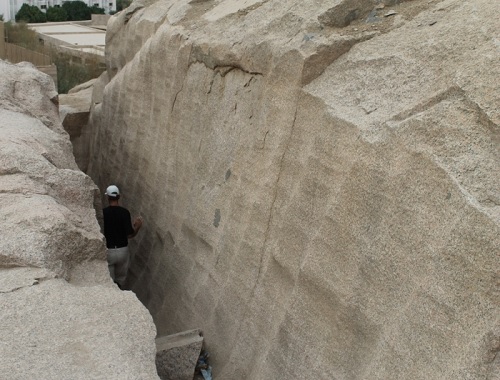
On
the wall on the right you can see what appear to be scoop marks in
the granite. Engineer Christopher Dunn theorizes that a machine was
responsible for this work, something akin to a massive belt sander
affixed to a crane or excavator.
Lost Ancient Technology In Egypt: The Evidence
The clearest evidence of this is in the constructions they left behind. And it is through the study of these works that we can see the level of technology each culture had, and what tools they used. Limestone is and has been in great abundance in the country, especially near Cairo, due to the laying down of sedimentary deposits millions of years ago. In fact, the famous Giza plateau is more or less a massive outcrop of limestone.
Both the Romans and Greeks had the use of steel, and thus could shape limestone with ease, as well as marble. However, the archaeological record shows us that the dynastic Egyptians worked with mainly bronze tools, such as chisels, as well as stone hammers. These would have been fine for the shaping of limestone, as in the columns and flat surfaces which make up many of the palaces and temples that we think of as dynastic achievements.
Limestone averages 3 to 4 on the Mohs scale of hardness, which is an indication of the ability of harder minerals to scratch softer ones. And bronze has a similar hardness, depending on what has been added to the copper base. The first bronze in any appreciable quantities was in use in Egypt starting in the 4th dynasty (2613 to 2494 BC) and this coincided, as most Egyptologists would have it, with the building of the three pyramids at Giza.
The stone often used was diorite, which has a hardness of 7, on average, on the Mohs scale. It was mainly in the form of ball shaped pounders which were used to strike the limestone as a way of removing material.
Now, rather than bothering to discuss how such tools, no matter how many there were and used by human hands, no matter how many could have used them with any kind of skill could have been responsible for the engineering marvels known as the Giza pyramids, I prefer to discuss how much of the work of ancient Egypt could not have been done by the dynastic Egyptians.
In order to shape stone, or wood, or practically any solid material, there is one simple principle; the tool material has to be as hard or harder than the material being worked on. Also, a power tool, that which is energized by electricity, water or some other force tends to remove material faster and more efficiently than a tool operated solely by hand. As well, powered instruments tend to be more accurate in their execution than those, which are solely human operated and energized.
This then leads to a true conundrum when we look, for example, at some of the shaped surfaces on the Giza plateau, because here, and many engineers can attest to this, we find evidence of the use of machine powered saws in deep antiquity. In order to get into any real depth about this, I will refer to the research of two great contemporary men, Stephen Mehler and Christopher Dunn, both of whom I traveled with in Egypt in April 2013.
Stephen Mehler is an oral tradition specialist and author of ancient Egypt knowledge; much of his tutelage came from his relationship with Abd’El Hakim Awyan. The latter was an Egyptian tour guide and indigenous wisdom keeper. Christopher Dunn is a master machinist, born and raised in England who moved to the United States and worked in high technology establishments which make, for example, specialized parts for jet engines.
Conventional Egyptology has a tendency to either ignore, or insufficiently try to explain the machined saw marks I witnessed, along with Mehler and Dunn on the Giza Plateau, as well as obvious examples of high-speed core drills having been at work at such sites as Abu Sir, near Giza. The important point is that the saw marks and drill holes that I and others have seen, in profusion in these and other areas were not so much in soft limestone, but in far harder rock like basalt, granite and diorite, as well as other tough stone.
All three of the above mentioned types of rock are at least 6 to 7 on the Mohs scale of hardness, and thus could not have been shaped using the copper or bronze chisels of the dynastic Egyptians, though many Egyptologists insist this is the case. As well, in many instances we can see the grooves that the saw blades and core drills left behind as they penetrated the stone. These marks tend to very even in nature, with each succeeding one representing one revolution of the saw or drill bit; something which is very difficult to do if done with hand tools, due to muscle strain over time.
According to some engineers that I have interviewed, the 2 to 3 millimeters distance between each successive rotation of the tools mentioned above matches, if not exceeds modern day diamond tipped equipment. So if the dynastic Egyptians, as well as the succeeding cultures did not have access to what we in the 21st century would call “high tech” tools, who did?
To explain this, we use the knowledge of Christopher Dunn to explain the how and why, and Stephen Mehler for the who and when. Dunn has published two very revolutionary books; The Giza Power Plant: Technologies Of Ancient Egypt, and Lost Technologies Of Ancient Egypt: Advanced Engineering In The Temples Of The Pharaohs.
In the Giza Power Plant he explores his theory that the Great Pyramid, and perhaps others were harmonic resonance devices, used to actually generate and distribute vibratory power. And in Lost Technologies Of Ancient Egypt he shows that ancient artisans left their marks all over Egypt, unique marks that reveal craftsmanship we would be hard pressed to duplicate today. Drawing together the results of more than 30 years of research and nine field study journeys to Egypt, he presents a stunning stone-by-stone analysis of key Egyptian monuments, including the statue of Ramses II at Luxor and the fallen crowns that lay at its feet. His modern-day engineering expertise provides a unique view into the sophisticated technology used to create these famous monuments in prehistoric times.
Stephen Mehler has also written two books pertaining to ancient Egypt. The first, The Land Of Osiris basically rewrites the history of the area thanks in large part to his decades long relationship with indigenous wisdom keeper Abd’El Hakim Awyan. In it, he explores the existence of a pre-pharaohnic civilization, called the Khemetians who were responsible for the creation of the Sphinx, pyramids of the Giza Plateau, as well as other monuments to the north and south. The name given to this area was Bu Wizzer, translated as meaning the Land Of Osiris.
In his second book, From Light Into Darkness: The Evolution Of Religion In Ancient Egypt he explores the idea that the three great western religions, Judaism, Christianity and Islam all evolved out of Egypt.
The work of both of these authors flies in the face of entrenched Egyptology dogma which insists that no defined culture preceded the dynastic Egyptians. However, by combining the works of Dunn and Mehler, a logical picture of ancient history arises which explains the hard stone artifacts found in the area displaying machine cutting marks.
To those that have not visited Egypt, you probably would be quite shocked at the amount of damage to the monuments which has occurred over the course of thousands of years. Casing stones of pyramids and other monumental refined works strewn about, shattered and harvested as building materials by later cultures, for example. It is the remains of the hard stone artifacts which are of particular importance, as in basalt, granite and diorite because, again, these are stones which the dynastic Egyptians could not have shaped.
Outside the Great Pyramid, within the first half hour of our being there, Christopher Dunn and Stephen Mehler both pointed out clear examples of black basalt that had been cut with a circular saw of some kind. And the best evidence, as far as I am concerned is at a site called Abu Sir, to the south of Giza. Here we saw many examples of core drilling in red Aswan granite, as well as saw cut marks in black granite.
And the most stupefying of all locations was the Serapeum, which is a subterranean passageway containing more than 20 large niches, and inside of each is an enormous granite box, with lid. The boxes are made of one piece of hollowed out stone, and the lid was originally part of that individual stone block.
by Brien Foerster
https://hiddenincatours.com/tour-of-lost-ancient-technology-in-egypt-the-evidence
Lost Ancient Technology Of Egypt: Obvious Evidence In The Aswan Quarry (Photographs)
Granite, specifically the pink to red, and sometimes black granite from the quarry at Aswan in southern Egypt was prized by the ancient Egyptians for making sculptures, obelisks, casing stones, columns, altars, etc. The enduring question is, if granite is a hard stone with a high percentage of quartz content, how could the dynastic Egyptians have shaped it with bronze chisels and stone hammers?
by Brien Foerster
https://hiddenincatours.com/lost-ancient-technology-of-egypt-obvious-evidence-in-the-aswan-quarry
Symbolist Egypt The Meaning Behind The Magic by John Anthony West (1:28:24)
https://www.bitchute.com/video/TVJgX1Dio6zK
The Mysterious Origins Of Civilization: John Anthony West and Graham Hancock (1:33:23)
Filmed in New York City, December 2016, a month before John was diagnosed with cancer. After a tough fight, he moved on to his next great adventure on February 6, 2018.
https://www.bitchute.com/video/Z2pp880of8Bd
Magical Egypt
The Home Of The Magical Egypt Series
“Magical Egypt - the best documentary series on the real mysteries of ancient Egypt and a tribute to the unique vision of the late, great John Anthony West.”
Graham Hancock
John Anthony West (24 Videos)
Playlist by Mark R. Elsis
https://www.youtube.com/playlist?list=PL9SLRU38-i-YOLw407uMhpEfjtKKLNhZf
About John Anthony West
https://grahamhancock.com/author/jawest
The Great Pyramid Of Giza And Advanced Mathematics (11:23)
by Graham Hancock
https://www.bitchute.com/video/avrpL35cceXg
Graham Hancock (12 Videos)
Playlist by Mark R. Elsis
https://www.youtube.com/playlist?list=PL9SLRU38-i-Y9KtvKAC0qL86hdBNZVLQI
Graham Hancock
Sources, and also an extensive amount of other incredible geodetic, mathematical, and astronomical information encoded in the Great Pyramid and Giza Plateau.
The Great Pyramid remained the tallest manmade structure on earth for 3,881 years after it was allegedly finished in 2,560 BC. The Cathedral Church of the Blessed Virgin Mary of Lincoln was the tallest building in the world upon the completion of its 160 metres (520 ft) high central spire in 1311; it was the first building to hold that title after the Great Pyramid of Giza, and held it for 238 years until the spire collapsed in 1548.
"New ideas that threaten an
established view are rarely received with open arms. Fearing the
wrath of the Church and the Establishment, Nicholas Copernicus
refused to have his findings published till after 1540, and only saw
a finished copy of On the Revolutions of the Celestial Spheres when
he was on his deathbed. A few decades later Copernicus's caution
proved to be justified. For in 1600, when the Hermetic philosopher
Giordano Bruno dared to uphold some of Copernicus's ideas, he was
thrown in a Papal dungeon and eventually dragged in the streets to
Campo Fiori in Rome and burnt alive at the stake by Dominican monks.
In 1632, thirty-two years after the death of Bruno, the astronomer
Galileo Galilei published Dialogue Concerning the Two Chief World
Systems -- Ptolemaic and Copernican. For having "held and
taught" Copernican ideas in his book, Galileo spent the last
eight years of his life under house arrest and was forced to 'recant'
his theories in front of the Bishops of Rome - this after having been
taken in the dark and damp dungeons of the Vatican and shown the
instruments of torture that would be used on him.”
Roberto Bauval
The Great Pyramid Of Giza: Decoding The Measure Of A Monument
"A comprehensive and concise analysis of the architecture of the Great Pyramid substantiates that advanced geodetic, astronomical and astrophysical information is encoded in the dimensions of the structure"
In this paper it is shown that, in all likelihood, the measurements of the exterior geometry, interior passages and chambers of the Great Pyramid were designed to impart geodetic, astronomical and astrophysical knowledge. It is suggested that the Great Pyramid is a repository of ancient knowledge in which it is demonstrable that an advanced level of mathematics was known including Newtonian Mechanics.
The following is a list of conclusions drawn from analysis of the relationship of dimensions found within and without the Great Pyramid:
- A precise definition of the Royal Cubit as it relates to the Earth
- The size and shape of the Earth
- The Mass and Density of the Earth
- The Gravitational Constant
- The Escape Velocity from the Earth to obtain an Open Orbit
- The Escape Velocity from the Earth to obtain escape from the combined Earth’s and Sun’s gravitational field
- The significance of the location of the Great Pyramid
- The Golden Ratio
- The Mass of the Sun
- The Mass of the Moon
- The Mean distance to the Sun and the Circumference of the Earth's Orbit
- Neutral Points of Gravity between the Earth and the Sun
- The Mean distance to the Moon
- The Orbital Velocity of the Earth
- The Orbital Velocity of the Moon
- The Metonic 19 year cycle of the Moon’s orbit of the Earth
- The Lagrange Point (L1) between the Earth and the Moon
- The Speed of Light
- The Orbital Velocity of the Solar System relative to the Center of the Milkyway Galaxy
- The Velocity of the Local Group of Galaxies which includes the Milky Way Galaxy relative to the Universe
by Eckhart R. Schmitz
http://thegreatpyramidofgiza.ca
The Great Pyramid Of Giza: Decoding The Measure Of A Monument
54. Key Numbers of The Great Pyramid
Within the geometry of the Great Pyramid we have seen numbers which may be interpreted as “key numbers”. These numbers are as follows:
1.618 = the Golden Ratio
5 = the number of levels of granite beams and hence Chambers above
the King’s Chamber
5 = the number of courses of masonry in the walls of the King’s Chamber
7 = the number of laps in the Grand Gallery’s walls
9 = the number of granite roof beams in the ceiling of the King’s Chamber
36 = the Latitude which the Great Pyramid’s Base Perimeter
relates to (Osculating Circle)
36 = the number of Roof Tiles on the ceiling of the Grand Gallery
100 = the number of Pyramid Inches in the Vertical and Transverse measure
of the Entrance and Ascending Passage height
100 = the number of Pyramid Inches in the diagonal of the Coffer in the
King’s Chamber
180 = the Number of Pyramid Inches of the length of the Granite Plug
in the Ascending Passage
2400 = the “Code Number” of the Queen’s Chamber
43,200 = the Scale of the Great Pyramid to the Earth
108,000 = the Associated Value of the King’s Chamber
by Eckhart R. Schmitz
http://thegreatpyramidofgiza.ca/content/index.html
The Great Pyramid Of Giza: Decoding The Measure Of A Monument (.pdf)
The Great Pyramid of Giza and the entire Giza Plateau may clearly be regarded as a repository of ancient knowledge. Perhaps the advanced scientific knowledge possessed by the builders was concealed from public knowledge and confined to the select few in order to avoid disrupting the prevailing religion. In this respect it would have been built for some future rediscovery. At present, we have only a fragmented understanding of the Civilizations that lived in the distant past. It is hopeful that we will find new evidence in the future which will further advance our limited knowledge. In any event we must retain an open mind and not rigidly confine our minds with preconceptions of what could have been know by our Ancestors.
by Eckhart R. Schmitz
http://thegreatpyramidofgiza.ca/book/TheGreatPyramidofGIZA.pdf
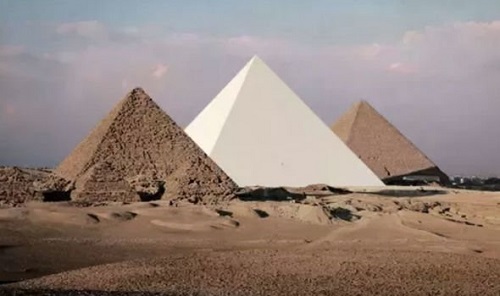
The
Great Pyramid was clearly designed to embody ages of knowledge of
astrological and mathematical proportion in a single sacred structure
that would last for all time. A key number embodied in this structure
is 432. The height and perimeter of the Great Pyramid are in a ratio
of 43,200 to the radius and circumference of the Earth. Take the
original height of the Great Pyramid (481.3949 feet) and multiply it
by 43,200 the quotient is 3,938.6855 miles. The modern measurement
for the actual polar radius of the Earth (from the pole to the
center) is 3,949.9028 miles. This equals 99.72%.
The Revelation Of The
Pyramids (2010) (1:46:00)
by Patrice Pooyard
https://www.bitchute.com/video/aaoVf5nK7PyU
Giza At Speed Of Light?
Some say that the location coordinates of the Great Pyramid of Giza match the exact number sequence for the speed of light expressed as 299,792,458 meters per second or 299,792 kilometers per second – all of which we can scientifically express as 1c. “Metabunk” debunks the claim without making a scientifically based analysis. Snopes says the claim is false but their “analysis” is not a scientific one at all. Who is right and who is wrong? Let us examine the available data…scientifically. The probability that the pyramid of Khufu was meant to be built at a latitude which represents the speed of light is very high: 99.97%. There is only 1 to 3,460 chance it is a coincidental match.
by Mario Buildreps
https://www.mariobuildreps.com/giza-speed-light
Decoding The Great Pyramid Of Giza
The Great Pyramid was placed in the exact center of all the land area of the world. Lines drawn through the north-south and east-west axis of the Pyramid divide equally the earth's terrain. The north-south axis (30° 9' meridian east of Greenwich) is the longest land meridian, and the east-west axis (29° 58' 51" north), the longest land parallel.
It is worthy of special note that the entire geometric structure of the Great Pyramid is designed on the basis of p (pi), 3.14159, the mathematical ratio upon which the whole physical universe is designed, and the value of y, 365.242, the number of days in Earth's solar year, (the time interval in days between two successive vernal equinoxes in the earth's journey around the sun).
Scientific Features:
Many features of the Great Pyramid exhibit design on the part of the Architect to embody relative scientific time and distance measurements in parts of the structure where they could not be overlooked. A few will be mentioned here, but only in briefest detail:
1). The sun's distance from the earth: For over 2,500 years man has struggled to solve this problem. The Greeks in 500 BC judged the distance to be about ten miles, later guessing it to be more like 2,000 miles. In later centuries man estimated it farther and farther away, until in the 16th century it had increased to 36,000,000 miles. The latest figures of modern astronomy give 92,900,000 miles as the sun's mean distance from the earth. As there was absolutely no way of calculating this until recently, scientists were astounded to discover that built into the Great Pyramid's base plans was a figure approximating 93,000,000 miles.
2). The mean density of the earth: The true mean density or specific gravity of the earth has also been an age-old problem. An average of prominent tests has placed it at 5.672 times the weight of water at 68 degrees Fahrenheit. The Pyramid places it at 5.7, a figure closely approximating the average estimates.
3).The weight of the earth: Knowing the density of the earth enabled physicists to ascertain its weight to be approximately 5,300,000,000,000,000,000,000 tons (in USA tons, about six billion trillion). The earth's weight and the weight of the Pyramid were found to be proportionately related to one another. The Pyramid's weight of approximately 5,300,000 tons has been noted to be 1,000,000,000,000,000 (USA one thousand trillionth) the weight of the earth. It is not unreasonable to assume that the Architect used this proportion to indicate the weight of the earth.
4). Volume of the earth's crust above mean sea-level; The vast amount of surveying necessary to determine the average height of all the land on earth would have been an impossible task even a few hundred years ago. With the advent of aerial photography and the accumulation of data from continuing geological surveys, together with modern computers, an estimate is now given as approximately 455 feet. The top of the Pyramid, as the builders left it unfinished, is fully 454 1/2 feet.
5). Mean ocean level of the earth: The mean ocean level was found to approximate 193 feet 7 inches below the baseline of the Great Pyramid. Again, modern computers and the findings of modern oceanography were required to ascertain this figure. And again the design of the Great Pyramid foretold this fact. It was found that taking twice the diameter (1,162.6") of a circle having a circumference of 3,652.42" (a circle again related to the solar year and base circuit of the Pyramid) gave a result of 2325.2" or just slightly over 193 feet 7 inches. This ancient wonder in architecture based upon the geometry of the year cycle is shown to be in harmony with the earth's design.
6). Mean temperature of the earth: As the Great Pyramid stands on the line which equally divides the surface of the northern hemisphere, there is a relationship between its climate and the mean temperature of all the earth's surface. This temperature is about 68 degrees Fahrenheit. In the Pyramid this temperature is maintained permanently and unvaryingly in the King's Chamber. Two air channels, when cleaned of sand, were found to keep this chamber at the normal of mean temperature, which temperature is exactly one fifth of the distance between the freezing and boiling points of water. Scientists say that 68 degrees Fahrenheit is the ideal temperature for the existence of man.
7). Rotundity of the earth: The rotundity, or curvature, of the earth was found by surveying the side baseline of the Pyramid. Due to the hollowed-in core masonry (35.76 inches on each side) a curved line was produced. Computations were made to ascertain how long the radius would be that would produce a circle containing that curve. The resulting answer was that the radius would bew approximately half the diameter of the earth.
8).Golden Rule of Architecture: The Great Pyramid confirms perfectly to the recognized laws of harmony and beauty. The Egyptians, Cretans, and Greeks all knew about the Golden Rule of Architecture, also called the "Golden Number." Such architectural masterpieces as the Parthenon on the Acropolis, at Athens, conformed to it, but not with the high degree of mathematical precision to be found in the Pyramid built over 2,000 years earlier. This "Golden Number," when worked out, turns out to be the cosine of the p angle of the Great Pyramid, expressed as correct to three decimal places, namely, 0.618; in other words, the ratio that the distance from the center of the Pyramid's base out to each of the four sides bears to the oblique height of the Pyramid's faces, is precisely the Architect's Golden Number, correct to three decimal places.
http://www.prophecyanalysis.org/decodingpyramid.htm
Pyramids Of Precession
The Great Pyramid was clearly designed to embody ages of knowledge of astrological and mathematical proportion in a single sacred structure that would last for all time. A key number embodied in this structure is 432. The height and perimeter of the Great Pyramid are in a ratio of 43,200 to the radius and circumference of the Earth. Take the original height of the pyramid (481.3949 feet) and multiply it by 43,200, the quotient is 3938.685 miles. The modern measurement for the actual polar radius of the Earth (pole to center) is 3949 miles.
All measures of interest are derived from three basic units: for distance, mass, and time. The United States of America is the last country to use the Imperial system for mass and time. The similarities with the pyramid inch mean this measurement is more in tune with the rhythms of the universe than the more convenient French derived metric system as shown by the many ways 432 can be derived from major measures of nature.
A pyramid inch is equal to 1/25 of a "sacred cubit" whose existence had earlier been postulated by Isaac Newton[3] who had noted how this number would produce whole numbers. The pyramid inch and sacred cubit are found as raised images on a red granite plaque at the entrance to the Antechamber of the King's room of the Great Pyramid. 1 pyramid inch = 1.00106 English/American inches, or 2.5426924 centimetres.
Early researchers beginning with John Greaves (1602 - 1652) found numerous apparent coincidences between the measurements of the pyramids and the geometry of the earth and the solar system. This has led researchers to conclude that the British system of measures was derived from a far more ancient, if not divine, system. This derivation of the Vitruvian Man by Leonardo da Vinci, depicts nine historical units of measurement: the Yard, the Span, the Cubit, the Flemish Ell, the English Ell, the French Ell, the Fathom, the Hand , and the Foot. The Vitruvian man was drawn to scale, so the units depicted are displayed with their proper historical ratios.
The principal argument was that the total length of the four sides of the pyramid would be 36524 (100 times the number of days in a year) if measured in pyramid inches.
During the 19th and early 20th centuries, this theory played a significant role in the debates over whether Britain and the United States should adopt the metric system[5]
The metric system was demeaned as being atheistic.
Time, on the other hand, has not been metricated in everyday use: years, months, weeks, days, hours, minutes, and seconds, with non-decimal conversion factors, are used.
Embedded Constants of The Great Pyramid:
Tropical Year or Calendar Year: The length of a base side is 9131 Pyramid Inches measured at the mean socket level, or 365.24 Pyramid Cubits, which is the number of days in a year [9 131/25 = 365.24, accurate to 5 digits]. The perimeter of the base divided by 100 = 365.24, the number of days in a year. [9 131 Pyramid Inches * 4 / 100, accurate to 5 digits].
Tropical Year: The length of the Antechamber used as the diameter of a circle produces a circumference of 365.242 (accurate to 6 digits).
Tropical Year: The ratio of the lengths of the Grand Gallery to the solid diagonal of the King's Chamber times 100 equals the number of days in a tropical year. [(1 881.5985600 / 51.516461) * 100 = 365.242200, accurate to 8 digits].
Sidereal Year: The length of the antechamber of the King's Chamber times Pi = length of a sidereal year [116.26471 Pyramid Inches * 3.14159 = 365.25636 days, accurate to 8 digits].
Sidereal Year: The length of a base side at sidereal socket level is 365.256 Pyramid Cubits. [accurate to 6 digits].
Mean Distance to the Sun: Half of the length of the diagonal of the base times 10^6 = average distance to the sun.
Mean Distance to Sun: The height of the pyramid times 10^9 represents the mean radius of the Earth's orbit around the sun, or Astronomical Unit (AU). [5813.235565376 Pyramid Inches x 10^9 = 91848816.9 miles].
Mean Distance to Moon: The length of the Jubilee passage times 7 times 10^7 is the mean distance to the moon. [215.973053 Pyramid Inches * 7 * 10^7 = 1.5118e10 Pyramid Inches = 238,865 miles].
Sun's Radius: Twice the perimeter of the bottom of the granite coffer times 10^8 is the sun's mean radius. [270.45378502 Pyramid Inches* 10^8 = 427316 miles].
Earth's Polar Radius: The Sacred Cubit times 10^7 = polar radius of the Earth (distance from North Pole to Earth's centre) [25 Pyramid Inches * 10^7 * (1.001081 in / 1 Pyramid Inches) * (1 ft / 12 in) * (1 mi/ 5280 ft) = 3950 miles].
Earth's Polar Radius: The Pyramid embodies a scale ratio of 1/43200. The height * 43200 = 3938.685 miles, which is the polar radius of the Earth to within 11 mi.
Radius of the Earth: The curvature designed into the faces of the pyramid exactly matches the radius of the Earth.
Equatorial Circumference of the Earth: The Pyramid embodies a scale ratio of 1/43200. The perimeter of the base * 43200 = 24,734.94 miles, which is within 170 miles of the equatorial circumference of the Earth.
Earth's Volume: The product of the pyramid's volume and density times 10^15 equals the ratio of volume to density of the Earth. [10339823.3 cubic cubits * 0.4078994 * 10^15 = 4.21760772 x 10^21 cubic cubits = 259.93 x 10^9 cubic miles].
Earth's Mass: Mass of the pyramid = volume * density = 10339823.3 cubic cubits * 0.4078994 Earth density = 4217497. The mass converted to pyramid tons = 4217607.72 * 1.25 = 5,272,010 pyramid tons. Since the mean density of the Earth was defined as 1.0, then the mass of the Earth is 10^15 times the mass in pyramid tons = 5.272 x 10^21 pyramid tons = 5.99 x 10^24 Kg.
Speed of Earth around the Sun: The Pyramid Inch times 10^8 = the speed of the Earth around the sun, circa 2600 BC.
Mass of the Earth: The weight of the pyramid is estimated at 5955000 tons. Multiplied by 10^8 gives a reasonable estimate of the Earth's mass.
Average Land Height: The average height of land above sea level for the Earth is 5449 inches. This is also the height of the pyramid.
The Light Equation: The height of the Great Pyramid, minus the height of the capstone represents one millionth the time it takes light to travel the mean radius of the Earth's orbit around the sun (1 astronomical unit) using 1 Pyramid Inch equals 24 hours (mean solar day). [(5813.2355653 - 103.0369176) / 10^6 = .0057101986+ days = 493.36116 seconds = 8 minutes, 13.36 seconds].
The Velocity of Light: With distance of one A.U. known and the transit time of light for this same distance the velocity of light can be found. [91848816.9 miles / 493.36+ seconds = 186169.5 miles/sec].
The Sun's Parallax: The size of the Earth as viewed from the Sun and expressed as an angle and generally taken to be 1/2 the diameter at the equator (Solar Equatorial Parallax) is 8.9008091 seconds of arc using 91848817 miles as the mean distance to the sun and 3963.4914 miles as the equatorial radius. The distance between the mean socket level and the height of the levelled bedrock is 8.9008 Pyramid Inches.
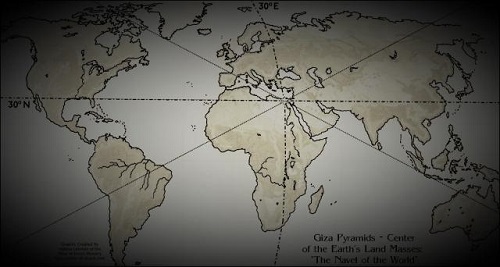
The
Giza plateau is located at the exact intersection
of the longest
line of latitude and the longest line of longitude.
Astronomical:
The Descending Passage pointed to the pole star Alpha Draconis, circa 2170-2144 BC. This was the North Star at that point in time. No other star has aligned with the passage since then.
The 344ft length of the Descending Passage provides an angle of view of only +/- 1/3 of a degree. Alpha Draconis has not been in alignment for thousands of years. The next alignment will be with the North Star, Polaris, in about 2004CE. Polaris in Greek means "Satan".
The southern shaft in the King's Chamber (45 deg, 00 min, 00 sec) pointed to the star Al Nitak (Zeta Orionis) in the constellation Orion, circa 2450 BC The Orion constellation was associated with the Egyptian god Osiris. No other star aligned with this shaft during that Epoch.
The northern shaft in the King's Chamber (32 deg, 28 min, 00 sec) pointed to the star Alpha Draconis, circa 2450 BC.
The southern shaft in the Queen's Chamber (39 deg, 30 min, 00 sec) pointed to the star Sirius, circa 2450 BC Sirius was associated with the Egyptian goddess Isis and is also part of a unique ceremony practiced by the African Dogon tribe.
The northern shaft in the Queen's Chamber (39 deg, 00 min, 00 sec) pointed to the star Ursa Minor, circa 2450 BC.
Pyramids mirror Orion Constellation: The pyramid positions on the ground are a reflection of the positions of the stars in the constellation Orion circa 10400 BC Five of the 7 brightest stars have pyramid equivalents: The 3 great pyramids of Khufu, Khafra, and Menkaura for the belt of Orion, the pyramid of Nebka at Abu Rawash corresponds to the star Saiph, the pyramid at Zawat al Aryan corresponds to the star Bellatrix. The only two missing star positions are for Betelgeuse and Rigel.
Marks Spring Equinox: Due to the angle of the sides of the pyramid vs. it's latitude, it casts no shadow at noon during the spring equinox.
Precession of the Equinoxes: The sum of the pyramid's two base diagonals in Pyramid Inches = length of the Precession of the Equinoxes (25827 years)
Precession of the Equinoxes: The distance from the ceiling of the King's Chamber to the apex of the pyramid = 4110.5 Pyramid Inches. Which is the radius of a circle whose circumference = the precession of the equinoxes. [4110.5 * 2 * Pyramid Inches = 25827]
Precession of the Equinoxes: The perimeter of the 35th course of blocks, which is much thicker than any of the other courses, gives a figure for the precession of the equinoxes.
Numbers of relevance:
The length of a base is 9131 Pyramid Inches from corner to corner in a straight line.
The length of a base side at the base socket level is 9131 Pyramid Inches or 365.24 Pyramid Cubits.
The length of a base side at sidereal socket level is 9131.4 Pyramid Inches or 365.256 Pyramid Cubits.
The length of the perimeter at the sidereal socket level is 36 525.63629 Pyramid Inches.
The perfect formula height of the pyramid including the missing apex is 5 813.2355653763 Pyramid Inches, calculated from perimeter of base divided by 2 Pyramid Inches.
The height to the missing apex is 5 812.98 Pyramid Inches.
The volume of the pyramid is: V = 1/3 base area x height = 161559817000 cubic Pyramid Inches = 10339828.3 cubic Pyramid Cubits. [(5813.2355653 Pyramid Inches)/3 * 9 131 Pyramid Inches * 9 131 Pyramid Inches]
Al-Ma'mun [786–833] ruling caliph from Baghdad who excavated his way into the pyramid to find only a sarcophagus and scant evidence of prior treasures. John Greaves (1602 - 1652) made a more accurate survey of the pyramids of Egypt than any traveller who had preceded him.
John_Taylor (1781-1864) rediscovered Pi and the golden ratio in the proportions of the pyramids.
Charles Piazzi Smyth (1819–1900)
Made the most accurate measurements of the Great Pyramid advancing the the pyramid inch, as was one twenty-fifth of a "sacred cubit", or 1.00106 British inches whose existence had earlier been postulated by Isaac Newton.
References:
The Authorship and Message of the Great Pyramid, 1953, Julian T. Gray, E. Steinmann & Co.
Back in Time 3104 BC to the Great Pyramid, 1990, S. G. Taseos
The Delicate Balance, 1989, John Zajac
The Egyptian Pyramids: A Comprehensive & Illustrated Reference, 1990, J.P. Lepre
The Great Pyramid: A Miracle in Stone, 1973, Joseph A. Seiss
The Orion Mystery: Unlocking the Secrets of the Pyramids, 1994, R. Bauval & A. Gilbert
Our Inheritance in the Great Pyramid, 1891, C. Piazzi Smyth
The Pyramids and Temples of Gizeh, 1885, W.M. Flinders Petrie
Secrets of the Great Pyramid, 1978, Peter Tompkins
https://www.carnaval.com/pyramids
The Great Pyramid And The Axis Of The Earth – Part 2
Perhaps the first interesting thing that one discovers about the Great Pyramid is that it is perfectly oriented to the four points of the compass – only being out by 3 arc minutes – a discrepancy of less than 0.06 percent. We are told that the most accurate north-oriented structure today is the Paris Observatory – however, even this is 6 arc minutes off from true north. Like a huge sundial, the sharp pointed shadows cast by the Great Pyramid from the sun's position in the sky, will naturally mark the annual dates of the summer and winter Solstices as well as the vernal (spring) and autumnal Equinoxes.
Now the above is common knowledge, however, what many of us have neglected to realise is that as the Earth rotates daily on its oblique axis of 23.5 degrees, the Great Pyramid will move between two extremes – i.e., 36.5º from the North Pole of the Ecliptic and 53.5º from the ecliptic plane – to 60º from the North Pole of the Ecliptic and 6.5 degrees from the Ecliptic Plane. So, the Great Pyramid having been built 30 degrees north of the Equator so that as the Earth turns it comes as close as 6.5 degrees to the ecliptic, is in itself a significant statement which is pointing directly to the obliquity of the Earth's polar axis . . . 30º subtract 6.5º = 23.5º It is indeed ironic that something as important as this is also something that is hardly ever mentioned in all the information given about the Great Pyramid.
by Scott Creighton and Gary Osborn
https://grahamhancock.com/creightons4
The Great Pyramid And The
Axis Of The Earth – Part 1
by Scott Creighton and Gary Osborn
https://grahamhancock.com/creightons3
The Great Pyramid - Reflections In Time
The precise location and placement of the Great Pyramid on Earth suggests that it is a building of supreme importance.
It's location at the precise centre of the geometrical quadrant formed by the Nile delta intensifies this focus.
It is aligned to within one twelfth of a degree to the cardinal points of the compass.
The design of the Pyramid is such that it is able to model a globe.
The Great Pyramid models the Earth in both its height and perimeter at the base at a ratio of 1:43,200.
The Great Pyramid reflects the area of the plateau on which it stands, the area of Lower Egypt and the circumference of the Earth at the Equator.
The Great Pyramid's estimated mass of 5.955 Million tonnes is approximately one billionth of the estimated mass of the Earth.
Astronomy and time are also reflected in the design. The orbit of the Earth and the distance of the Earth from the Sun are both revealed in its dimensions.
The length of a Great Year of (25,826.4 years) is indicated by the sum of the diagonals in the structure.
The Great Pyramid is also able to model nature in that the internal ratios in its design fit the Fibonacci series.
Further we saw how it is possible to establish the basic unit of measurement used in the pyramid's construction. Namely the Pyramid or Primitive inch and how that unit is very closely related to the standard British Inch of today's measurements. We also saw how that inch measurement is a function of planet Earth's mean polar radius to an accuracy of six digits.
That the maxima and minima of the Earth's orbit are reflected in the design.
That the Earth's orbit of 185,984,540 miles is reflected in the design.
That the length of the Solar Tropical Year, of 365.242 days is a key factor to its design.
That the length of the Sidereal Year, of 365.256 days, is a key factor to its design.
That the length of the Anomalistic Year, of 365.259 days is a key factor to its design.
by John Tatler
http://www.biblebelievers.org.au/pyramid.htm
The Great Pyramid Of Giza
Latitude Positioning and Proof of an Ultra Advanced Ancient Civilisation
Now the key value of interest here is the ratio, which indeed at first one might be tempted to dismiss as being of no importance. This would be a great mistake however, as the value appears to have immense significance. Specifically, the sequence of numbers that comprise it closely match those that make up none other than the ratio between the current earth tropical year, and an ideal value of 360 days:
365.2421897 / 360 = 1.014561638
Essentially, the noted ratio associated with The Great Pyramid is practically dead on 10 times the value for a change in the earth year from an ideal of 360 days to its present value. Now it has previously been discussed at length in other articles that dealt with Egyptian astronomy, that the ancient Egyptians themselves were adamant in their belief that the earth did once possess a 360 day orbit. But that a fundamental shift or disruption to the cosmos in its early stages, altered the orbit of our planet, giving it its current tropical year of 365.2421897 days.
In light of the above analysis one must conclude that the ratio of 10.14561638 (10 times the tropical year increase from 360 to 365.2421897 days) was intentional. The builders actively sought to realise this ratio between the two noted measures: (X × 4) / Z. The very latitude placement was thus determined by the ratio. It was the governing principle that led to it being built precisely where it was, north of the equator. Now it is critical to note that in accurately determining the elliptical arc distance from the equator to the centre of the pyramid, it is undeniable that the builders knew the dimensions of the earth form to our present day standard (WGS84).
by Keith M. Hunter
https://www.lostagesecrets.com/Great-Pyramid-of-Giza.html
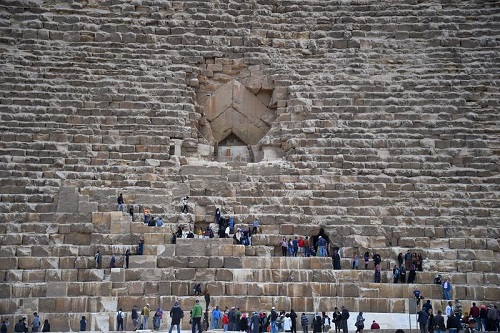
The
original entrance is clearly shown above with the triangular
lintel.
Tourists are entering through the "Robbers Tunnel."
The Main Entrance to the Great Pyramid is blocked up on the north
face of the structure. In fact, it was hidden until 820 AD when the
caliph Abdullah Al Mamun used men to bore into the structure,
creating the Robber’s Tunnel. While they were excavating, they
found the true entrance. It is through the Robber’s Tunnel that
tourists enter the pyramid today. After a horizontal journey of
approximately 90 feet, it finds the original interior passageways.
The Precession Of The Equinoxes
The precession of the equinoxes refers to the observable phenomena of the rotation of the heavens, a cycle which spans a period of (approximately) 25,920 years, over which time the constellations appear to slowly rotate around the earth, taking turns at rising behind the rising sun on the vernal equinox.This remarkable cycle is due to a synchronicity between the speed of the earth's rotation around the sun, and the speed of rotation of our galaxy.
It is now suggested that at some point in the distant past this cycle was determined by astronomers (A process requiring the prolonged and precise observation of the equinoxial conjunction of the rising sun and the 'suns carrier' behind). Such a discovery goes a long way to understanding the prehistoric fascination with astronomy and the apparent 'will to move mountains' exhibited by the builders of many megalithic monuments. Lockyer observed that prehistoric astronomy was started on the horizon, which would go a long way towards explaining the early development of the English structures called 'Henges', with their built-up banks creating excellent artificial horizons.
The Precessionary cycle is measured in 'months' named according to the constellation visible behind the vernal equinox sunrise. We are presently finishing the 'age of Pisces' and will be soon entering the 'age of Aquarius'. It is suggested (and supported by a growing weight of evidence), that this cycle was recognised at least as far back as the age of Taurus, although there are suggestions of recognition as far back as Leo (as represented by the Sphinx at Giza).
http://www.ancient-wisdom.com/precession.htm
Pyramids Of Egypt
Precession Numbers and Degrees of Angles
One of the most intriguing aspects of the pyramids of ancient Egypt appears to be the distinctive degrees of their angles of inclination. The precision with which most of the ancient pyramids were made is reflected in the number of degrees chosen. Aside, then, from the preciseness of the technical execution of the masonry work in which stones were placed together with unimaginable exactness; aside from the placement of the Great Pyramid regarding the north-south coordinates of the Earth; one can only marvel at the distinctive angles of degrees employed in those ancient structures. Numerous discussions and interpretations exist as to why specific degrees were chosen. None seem to be possibly related to the reasons behind why the ancient architects chose those particular degrees of inclination.
by Charles William Johnson
https://earthmatrix.com/giza/egypt_numbers_angles.htm
Historical Accounts Of The Great Pyramid.
The structures at Giza have suffered from natural erosion, defacement, pillage, additions and alterations, all of which have reduced us to interpretation in order to visualize the complex in its original condition. In order to compensate for the lack of original Egyptian references, it is worth first exploring the accounts of the earliest explorers, whose observations read like the frames of a film.
http://www.ancient-wisdom.com/ghizahistoricaccounts.htm
The Khufu Pyramid
The Subterranean Chamber, the Recess and the horizontal passageway.
https://khufupyramid.dk/inside-dimensions/the-subterranean-chamber
Measurements Great Pyramid And Giza Layout
Source: The Great Pyramid Passages And Chambers" Volume 1 by John and Morton Edgar, 1910
Please ignore good old Mr. Edgar, he just needed a break in the dusty and harsh environment with poor quality of air.
The picture is taken from the lowest part of the descending passageway. You can see the connection to the horizontal passageway leading into the Recess or Antechamber and the Subterranean Chamber. The width and the height of the horizontal passageway is smaller than the descending passageway, which is easily viewed on the picture. Please also observe the roughly cut walls, which made the dimensions of the passages difficult to measure and to draw. For this area I have chosen to use mean values. Flinders Petrie mentioned: "The Subterranean chambers and passages are all cut roughly in the rock. The entrance passage has a flat end, square with its axis (within at least 1°), and out of this end a smaller horizontal passage proceeds, leaving a margin of the flat end along the top and two sides. This margin is 4.5 wide at E., 3.2 at W., and 5.4 to 6.0 from E. to W. along the top."
by John W. Gerson
https://www.gersongreatpyramidgiza.com
Solving The Giza Puzzle
In this paper, I present facts that will change our understanding of why the Giza pyramids were built, and also when this was done. Let us first look at the exact features of the Great Pyramid in the Northeast corner of the Giza plateau near Cairo in Egypt. The base width of the Great Pyramid is 230.38 meters, and the original height was 146.61 meters. By using the Theorem of Pythagoras, we can calculate the length of the side to the apex from the middle of the base. This side length is 186.45 meters. The ratio between the halve of the base length and the side length is 1 : f. Did the pyramid builders knew about the Golden Mean, or is this just a coincidence? Let us add two side lengths and then subtract the height from this sum: 230.38 + 230.38 – 146.61 = 314.15 The outcome shows the first five digits of p. Did the pyramid builders knew about p, or is this just a coincidence?
by Johan H. Oldenkamp, Ph.D.
http://www.pateo.nl/PDF/SolvingTheGizehPuzzle.pdf
Dimensions
And Mathematics Of The Great Pyramid
Exact measurements of the Great Pyramid were first made by W.M. Flinders Petrie, and published in 1883 by the Royal society in his book, "The Pyramids and Temples of Gizeh". The Great Pyramid was professionally surveyed by J.H. Cole, and the measurements were published in his "Determination of the Exact Size and Orientation of the Great Pyramid", published by Government Press, Cairo, 1925. Many of these measurements were subsequently recorded in "The Great Pyramid Decoded", by Peter Lemesurier, 1977
https://www.theglobaleducationproject.org/egypt/studyguide/gpmath.php
The Giza Plateau
One of the seven world wonders is the Great Pyramid at the Giza plateau by the side of the Nile near Cairo. The pyramid has been researched since the dawn of modern history. Piles of books have been written about the enigmatic Great Pyramid alone. Many of these books stem from Egyptian archaeologists. Egyptologists haven’t changed their view about the Great Pyramid very much in the last hundred years. Pyramidologists date the construction of the Great Pyramid back to 2589 B.C. and it is supposedly created as a burial site, the tomb of pharaoh Khufu (Cheops in Greek). Leading pyramid expert is Dr. Zahi Hawass, chairman of the Supreme Council of Antiquities (SCA) in Egypt, who fiercely adheres to the tomb theory of the Great Pyramid. Although there is a sarcophagus inside the King’s chamber of the Great Pyramid, no mummy has ever been found inside the pyramid. This sarcophagus must have been made inside the pyramid since due to its size it cannot be removed from the King’s chamber any more.
http://www.soulsofdistortion.nl/SODA_chapter8.html
Great
Pyramid Coordinates
The question frequently posed regarding the GP {Great Pyramid of Giza}, being, is it actually indicating its own location upon planet Earth so to speak, furthermore if so, is there “proof” of this extraordinary concept. Similarly a good friend, moreover published author, Gary Osborn, whose website link is indicated, has revealed numerous sources with reference to an Earth “tilt” of 23.5 degrees, plus a great deal more, his conscientious research conclusions, are indeed worthy of note The following may perhaps, then again, may not, assist in solving the conundrum I forever employ a GP height of 480 with a GP base side length of 756, even though I have a preference re the term “units” we may as well term them modern-day “feet” else there will be misunderstanding.
by Derek Skhane
https://skhane.org/great-pyramid-coordinates
Metron Ariston
Observations On The Great Pyramid
"Metron Ariston" is a book written in 2002 and published on 11 February 2003 in Athens,Greece (275 pages - in Greek). ISBN 960-8286-06-9 Contents: Introduction (about the new measurements made in 2002 and the Megalithic Cubit), Tiryns, the Pyramid of Proetus, Mycenae, Orchomenos (Boiotian), Hyle (Gla), Pylos and Crete, Athens, Parthenon and Stonehenge.
https://athang1504.blogspot.com/2011/02/observations-on-great-pyramid.html
The Great Pyramid’s
Conspicuous Speed Of Light Latitude Is No Accident
The Sphinx patiently weathered a hostile climate until the Great Pyramid was constructed, whose latitude in degrees tallies with the speed of light, c = 299,792 kilometers per second, to six a significant digits. The pyramid’s geometry showcases both pand the golden ratio, f, with the conjunction p-f2˜p/6˜f2/5 not only providing a natural basis for the cu-bit/metre ratio but also approximating the speed-of-light latitude in radians. Its scaling re?ects the size of the Earth and its rotation rate. By relating cubits to metres and days to seconds, this mighty monument quite deliberately encodes the value of c, guratively permitting the conversion of energy to mass. Parallels exist with a recent analysis of Avebury, which also demonstrates ancient knowledge of modern physics.
by Robin James Spivey
The Equation Earth Gravity And The Great Pyramid Of Giza
We will demonstrate that the gravitational characteristics of the Earth conducive to the emergence of life as we know it, appear indisputably in the dimensions of the Great Pyramid of Giza and that these same dimensions are linked to a very simple, unique, and magnificent equation. That the anomaly observed of 6° of the orbit of the Earth with the the plane of the equator of the sun is engraved deeply inside the architecture of the Great Pyramid and that it is as well the reason for the divergence between the flattening factors of the Earth.
by Jean Seimple
https://www.academia.edu/51019594/THE_EQUATION_Earth_Gravity_and_The_Great_Pyramid_Of_Giza
The Mathematical Genius Encoded In The Great Pyramid
Across the shifting sands of time, nowhere has remained more mysterious than ancient Egypt. This desert beacon continues to allure millions due to its unsolved secrets, theories, and godlike pharaohs. But perhaps the greatest reason for Egypt’s enduring popularity is a theory that places the age of this enigmatic land’s monuments so far back in history that Egyptology’s explanations seem untenable. This ultra-ancient origin has led many to surmise that the people who built these physical structures were capable of such an advanced level of engineering, in which they encoded the mathematical principles of life itself. The architects of ancient Egypt’s monuments were far more purposeful in their proportions, measurements, angles, and equations than most modern-day archaeologists credit them with. There is also the distinct possibility that these architects found a way to naturally harness electricity from the Earth itself.
by Tasha Shayne
https://www.gaia.com/article/the-mathematical-genius-encoded-in-the-great-pyramid
The
Great Pyramid Of Giza
There are three known chambers within the Great Pyramid. There is a subterranean chamber which is believed to be unfinished because of its rough appearance. Followed by the so-called Queen’s Chamber which is in the center of the pyramid above the Subterranean Chamber, and the so-called King’s Chamber above the Queen’s Chamber. There is an entrance to the Great Pyramid of Giza on the north side, which was found only after dynamite was used to blast a whole into the pyramid. Upon entering the pyramid you travel a downward-sloping passage which ultimately goes to the subterranean chamber. Though an upward sloping passage intersects with the entryway passage called the Ascending Passage. This takes you to another intersection where one passage breaks off horizontally taking you to the Queen’s Chamber. While the ascending passage continues upwards in what is called the Grand Gallery to the so-called King’s Chamber.
by Brandon West
http://www.projectglobalawakening.com/great-pyramid-of-giza
The Great Pyramid
The Great Pyramid at Giza - the greatest stone structure on the planet. The largest, most enduring, most accurately engineered, most enigmatic, and most difficult-to-duplicate stone monument of all time. No official inscriptions, no paintings, no carvings, no records of its construction, no easily understood reference to it of any kind anywhere in Egypt until at least 1000 years later. No explanations. No burials. After centuries of research and debate, scientists and scholars around the world are still trying to determine exactly who built it, when, how, and why. Conclusive historical evidence has not been found and the factual paradoxes are profound.
Huge core blocks over the original outer entrance hint at complex structural engineering over all the interior passages and the grand gallery. Petrie's observations on the joints between the casing stones: "an area of some 35 sq. ft. each, the mean variation of the cut stone from a straight line and from a true square, is but .01 in. on a length of 75 in. Up the face the mean opening of the joint was but 1/50 in., yet the builders managed to fill the joint with cement. . . the weight of the stone to be moved - some 16 tons . . .to merely place such stones in exact contact at the sides would be careful work, but to do so with cement in the joints [and without chipping] seems almost impossible." Many blocks meet at compound angles and each stone is individually fitted to all adjacent stones. The 13-acre foundation varies from true level by less than 1 inch.
https://www.theglobaleducationproject.org/egypt/studyguide/9greatpyramid.php
Giza Pyramid
Great Pyramid Of Giza Research Association
Welcome to the world's largest research association and leading website for information on the Great Pyramid of Giza with an International Advisory Board comprised of 30 prominent researchers and a membership of over 5000.
The Great Pyramid Of Giza: A Modern View On Ancient Knowledge
After extensive research Dutch researcher Willem Witteveen connects data from his own findings with that of other researchers, resulting in groundbreaking conclusions about the true function of the Great Pyramid and its place in history. The Greek mathematician Pythagoras stated: "All is number." The American prophet Edgar Cayce claimed: "Sound is the medicine of the future," and the late Egyptian wisdomkeeper Abd 'el Hakim Awyan always said: "It is all about sound."
Willem Witteveen proves that all these men were right and that what we now regard as groundbreaking and new often originated in ancient Egypt, well before the first Egyptian dynasties. This book is divided into five main parts, four of which relate to the four earthly elements Earth, Water, Air and Fire. The fifth part relates to the element or quintessence called Aether. Within this circle all processes on Earth and beyond take place, and the element Aether represents the divine world and is the carrier of all information.
The author demonstrates that the Great Pyramid is an enormous library of knowledge, intended for modern generations and containing the golden frequency of Giza, one of the basic values responsible for creation and the existence of life on Earth. We ourselves are the architects and builders of these magnificent ancient monuments. We ourselves in the future tense! Witteveen discusses such topics as sound and resonance, antennas, the Schumann frequency, and the special abilities of quartz, hydrogen and wavelengths. A fascinating and visual book!
by Willem Witteveen
https://www.goodreads.com/book/show/28650478-the-great-pyramid-of-giza
Fingerprints Of The Gods
On 6th July 1960 Lt Colonel Harold Ohlmeyer, a United States Airforce Commander, sent a reply to a letter from one Professor Charles Hapgood who had requested his opinion on a feature found on a map of 1513 AD called the Piri Reis Map. Lt Colonel Ohlmeyer’s reply was a bombshell. The map, showing the coastline of the east coast of the Americas and the west coast of Africa, the Colonel remarked, also seemed to show the coastline of Queen Maud Land in Antarctica free of ice – a condition it had not been in for some 9000 years! In fact, it is only in recent times that modern man has been able to map this coastline using sub-surface surveying techniques that can penetrate the ice sheet that lies on top of it. Ohlmeyer had no idea how a map existing in the 16th century could have got hold of such knowledge.
by Graham Hancock
https://grahamhancock.com/fingerprints
Secrets Of The Great Pyramid (Book 1978)
Ancient Background -- Medieval Exploration -- Renaissance and Revival of Interest -- The age of Enlightenment -- Exploring with Chisel and Gunpowder -- First scientific Theories -- Scientific Theory Developed -- A Theodolite for Surveyors -- Almanac of the Ages -- Astronomical Observatory -- Astronomical Temples of Egypt -- Geodetic and Geographic Landmark -- The Golden Section -- Scientific Survey Gives Geographical Proof -- Decline of Ancient Knowledge -- Who Built the Pyramid? When? and How? -- Why were the Pyramid Passages Plugged? When? And How? -- Temple of Secret Initiation -- More Secret Passages and Chambers -- Astrological Observatory.
by Peter Tompkins
https://archive.org/details/secretsofgreatpy0000tomp
Abd’el Hakim Awyan
Born and raised in the small village of Nazlet El Saman at the very edge of the Giza Plateau, with its Pyramids and Sphinx, Abd’el Hakim Awyan developed an interest in the true origins of the many monuments and artifacts of ancient Egypt from a very young age. His keen insight guided him to see a totally different view of Egypt’s past than what has been written by traditional historians. Hakim, whose name means “the wise one” or “wise healer”, quickly felt a deep connection to the information as he learned and discovered it. Driven by a need to know more, he embarked on a lifelong study of the full scope, and possible impact that this information might have on our world. He utilized the knowledge gained from acquiring degrees in both archeology and Egyptology throughout his 50 years of fieldwork, traveling throughout Egypt, researching and studying at the many sacred sites.
https://www.khemitology.com/hakim
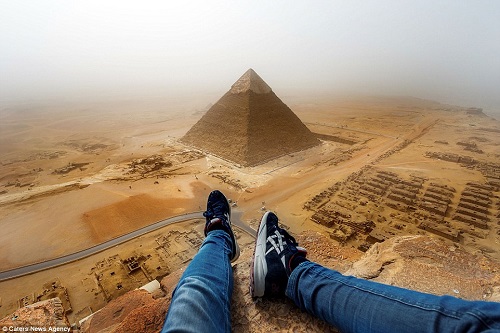
Andrej
Ciesielski From Munich On Top Of The Great Pyramid
The Great Pyramid Of Giza Was Built By
An Extremely Advanced Ancient Civilization
While many questions remain unanswered about the Great Pyramid of Giza, we still remain perplexed by the complexity and precision of this incredible ancient structure.
Researchers have yet to answer numerous enigmas about the Great Pyramid, enigmas that prevent us from solving the puzzle surrounding this mysterious antique construction that has baffled researchers, historians, and tourists alike. Interestingly, the great pyramid is the only remaining structure of the 7 wonders of the ancient world.
It remains a profound mystery the fact that the Great Pyramid of Giza was built with such precision, how people managed to quarry and transport huge blocks of stone and incorporate them creating the pyramid is a mystery that no one has been able to properly explain. The fact that The Great Pyramid is the most accurately aligned structure in existence and faces true north with only 3/60th of a degree of error is something mind-boggling.
Not only is the Great Pyramid one of the most accurately aligned structures on Earth, there are numerous other details about it that are even more incredible.
In this article, we go through 15 points about the Great Pyramid which are the ultimate evidence that this incredible ancient structure was built by an ancient civilization that was far more advanced than what mainstream scholars are willing to admit.
Pi And The Great Pyramid Of Giza
The oldest of the Seven Wonders of the Ancient World, The Great Pyramid of Giza, also known as the Pyramid of Khufu or the Pyramid of Cheops, situated in Cairo, Egypt, is really a thought provoking enigma. The value of the mathematical constant Pi seems to have designed into the Great Pyramid to a value of about 3.1419. But we know that this value of Pi was not discovered at that time with such accuracy. A very interesting point here is that how did the Egyptians know or use an approximate value of Pi? The explanation of this question involves a simple scientific logic. Let us find it out.
by Anvesha Kushwah
https://mathshrc.com/Journal/articles/a15/a15.html
Phi, Pi And The Great Pyramid Of Egypt At Giza
The Great Pyramid of Egypt closely embodies Golden Ratio proportions.
Great Pyramid of Giza, Egypt with golden ratio proportionsThere is debate as to the geometry used in the design of the Great Pyramid of Giza in Egypt. Built around 2560 BC, its once flat, smooth outer shell is gone and all that remains is the roughly-shaped inner core, so it is difficult to know with absolute certainty. The outer shell remains though at the cone, so this does help to establish the original dimensions.
There is evidence, however, that the design of the pyramid may embody these foundations of mathematics and geometry: Phi, the Golden Ratio that appears throughout nature. Pi, the circumference of a circle in relation to its diameter. The Pythagorean Theorem - Credited by tradition to mathematician Pythagoras (about 570 - 495 BC), which can be expressed as a² + b² = c². So how might the Great Pyramid have embodied these concepts? There are a number of theories to explore.
by Gary Meisner
https://www.goldennumber.net/phi-pi-great-pyramid-egypt
Golden Ratios In Great Pyramid Of Giza Site Topography
Overview: Analysis of the site of the Great Pyramid of Giza reveals that the positions and relative sizes of the pyramids may be based on the golden ratio.
Evidence of the Golden Ratio in the Great Pyramid complex. There are many pyramid theories and questions as to who built the pyramids in ancient Egypt. It's commonly known though in Egyptology that the proportions of the Great Pyramid of Egypt are within inches of a golden ratio-based pyramid. This is discussed in detail in my article Phi, Pi and the Great Pyramid. Some say, however, that this single piece of evidence is just a simple coincidence. The primary rationale given to deny this claim is that there is no written historical evidence that the ancient Egyptians had any knowledge of the golden ratio. That's a reasonable objection, but what if the evidence showed that the application of the golden ratio at Giza was not limited to the Great Pyramid? That evidence is presented in this article.
by Gary Meisner
https://www.goldennumber.net/great-pyramid-giza-complex-golden-ratio
The Great Pyramid
An Equation in Stone, a 4,500-Year-Old Mystery Solved
It was respect for the masterful achievements of the builders that encouraged the author to take up the challenge they placed before the future. The submitted evidence herein consists of but a brief fragment of decades of considerable contemplation. Among the many remaining and tantalizing questions is, precisely who were the builders, and what was their motivation when constructing the largest building on Earth—the Great Pyramid? The Great Pyramid remains, intentionally or otherwise, the builders' gift to mankind. It is a truly grand puzzle left behind for unborn generations to ponder and to solve. That the builders wanted their puzzle solved is plainly indicated, because they left behind a concise set of carefully linked clues, a trail of “breadcrumbs” leading directly to its solution.
by D. Arthur Gusner
https://www.galaxyquestbooks.com/the-great-pyramid-equation-in-stone
Egyptian Numerology: The Pythagorean Triangle And Its Esoteric Meaning
Some Historic Notes and Brief Comments on Sacred Geometry
The Egyptians believed in the importance of numbers.1 Perhaps the fore-most proponent of this reality was the leading student of symbolist Egypt, Réné Schwaller de Lubicz (1887-1961) from Alsace-Lorraine, France: “Schwaller de Lubicz’s second thesis is mathematical. Both the deliberate use of harmonic proportions in art and architecture and the numerical basis underlying Egyptian myth compelled him to a detailed reconsideration of Pythagoreanism, and to the construction of a system of thought consonant with the masterpieces of Egypt- with the fact of an empire that lasted four thousand years.
“‘Number is All’, declared the Pythagoreans. What is today called Pythagorean number mysticism is Egyptian in origin (if not older still) and corresponds to the underlying philosophy behind all the arts and sciences of Egypt. In effect, what Pythagoras did was to un-dramatize myth-a strategy that had the advantage of talking directly to those capable of thinking along these lines.
“The work of Schwaller de Lubicz and the independent but complementary work of a few other contemporary thinkers (J.G. Bennett, for example) has made it possible to re-express Pythagorean theory in a way acceptable to our thinking. When we reapply this to Egyptian myth it becomes clear that these curious tales are based upon an understanding of number and the interplay of number, not upon animism, tribal superstitions, priestly feuds, the raw material of history or dreams.”
by Antonietta Francini, S.R.C., M.D., with Benefactor Taciturnus, F.R.C.
https://ba278b9d8106536501a2-57da1f3fe93ccf3a9828e6ce67c3d52c.ssl.cf5.rackcdn.com/ws_05_francini.pdf
Great Pyramid And Vesica Pisces
The Great Pyramid Of Giza - Temple Of Constants
The Great Pyramid of Giza is the single most awe inspiring terrestrial achievement of mankind. It has inspired the great questions upon individuals and civilizations for millennia, while at the same time, offering its subtle answers in plain sight. As the greatest "wonder of the world," it has been thoroughly researched, measured and analyzed. Countless people of extreme talent and intellect have devoted their lives energy toward solving this structure's many riddles, and nearly every human to bear witness to it has wondered of its purpose. Even after thousands of years of scrutiny, the pyramid continues to unravel fantastic new correspondences to the dimensions of nature, as well as the question "how?!"
Yes, this article is just another shot at penetrating this great mystery and the insights within are not entirely my own. I stand upon the shoulders of all others, trying to capture sight of its light. However, you will find novel insights in my article below, and perhaps you will find greater understanding as to why so many correspondences exist within the symphony of "coincidence" that is the Great Pyramid. I intend to keep this a living document as marvelous information tends to flow continuously out of the analysis of this geometry and simply may not be captured in a single effort of composition.
To Square the Circle
There has been a fundamental problem that has been juggled throughout human history. It is as if the answers are lost and found again, to be lost and found again, over and over throughout time. It can be traced threading through most ancient civilizations and on up through present day. The history of this question is virtually the history of human mathematics and our intellectual achievements as a species. During the gold ages of history, such as the age of the pyramids, the problem and its solution are revered. This problem is known as the "squaring of the circle," or the "quadrature of the circle" and it concerns the composition of a circle of the same circumference as a square's perimeter (the question is also posed to the composition of equal areas.) Ultimately, a definitive method is sought that may achieve this feat in a number of steps.
The Vesica Blueprint
Perhaps the Great Pyramid, in all its impenetrable mystery owes its basic blueprint to the Vesica Pisces? Perhaps the Great Pyramid is full of remarkable mathematical correspondence not because it is an abstract and random act of untraceable (or alien) genius, but because its core concept emerges from within the dimensions of this first act of nature?
Here we see how an extremely close approximation of the height to base relationship and slope angle of the pyramid may be found by tracing the positions of a Vesica Pisces placed within a Vesica Pisces. Remember, this represents 1/3rd, or 33.333... %. The corner slope view, or diagonal length to height ratios also fit within this same geometry. Again, in terms of ratios and harmonics, the fact the Great Pyramid design comes about as the relationship between a Vesica Pisces and another a 3rd of its size, implies that the structure is in essence about the triangulation of the "fundamental tone."
This relationship as far as I am concerned is the most critical concept in mathematics as well as the harmonic laws dictating energy transfer on a physical level. It surprises me not that it is given prime significance throughout history's philosophic institutions. The fundamental tone, (or any vibrating medium's principle oscillation) when it is self divided via the harmonic series, finds the first new tone at the 3rd overtone, which is an octave and a perfect fifth of the fundamental. As any student of music theory knows, the perfect 5th is the most harmonious tone amongst all others apart from the octave, and through the circle of fifths, all western music theory may be derived. Many have attributed this most harmonic and eternal relationship as the holy trinity.
Yet there is another critical function of triangulation which is not as commonly recognized, much less revered. The equilateral triangulation of the octave (which essentially produces the tonic, major 3rd and minor 6th intervals) is the principle act of triangulation amongst all ascending and descending wavelengths- it provides us with an inherent value of Phi- the "golden ratio." Phi is the all important ratio- the ratio of 1 to itself! This fact is critical to understanding magnetic currents, electromagnetic field mechanics and induced distribution on all scales of our continuum. This is not simply fancy number games we are talking about here- this is critical information that pertains directly to natural energy principles, or any applied technology that hopes to make use of them.
Is this also part of the message of the Great Pyramid?
by Clay Taylor
https://www.artofclaytaylor.com/single-post/2017/03/23/the-great-pyramid-of-giza-masterpiece-of-dimension
The GPS Coordinates Of The Great Pyramid Encode The Speed-Of-Light, Pi, And The Euler Constant. Why?
The modern GPS coordinates of the Great Pyramid encode the speed of light (c), as well as Pi (p), and the Euler constant (e), using information that did not exist until modern times - indicating a temporal anomaly in which data somehow went backwards in time.
It’s been said for some many years that the latitude of the Great Pyramid is exactly the same number as the speed of light. This fact was noted by the CIA decades ago, has been in the public domain since at least 2005, and went viral as an internet meme last year - but the fact has long been dismissed as coincidence by sceptics/debunkers.
During a recent research project I needed to reference a recent book, Rendlesham Enigma, which states that the Great Pyramid GPS location was given to a UFO witness by time-travellers! This weekend, I decided to investigate that outlandish claim, which led me to scrutinise the theory about the GPS coordinates also mentioned in the book.
Fact: I can confirm that the speed of light constant, c, is exactly the same number as a latitude (East) coordinate falling within the perimeter of the Great Pyramid!
This finding piqued my curiosity, because it is, at the very least, an extraordinary coincidence - a synchronicity. A GPS coordinate consists of two numbers, latitude (North) and longitude (East). I felt that, if the N coordinate were important, perhaps the E coordinate merits closer attention.
I checked to see how much the Pyramid has moved since ancient times due to geological processes, so I could account for both old and new locations. The first article that came up in Google provided figures for the slow northward movement of the North African tectonic plate, and also for the slow westward movement of the pyramid due to a process called Euler rotation. Euler… I know that name. He also discovered one of the most important constants in mathematics: the Euler constant.
So I Googled for constants, and on the first page that came up in Google I found the “Euler” constant. I planned to explore various constants, but I tried the first one that caught my attention: p/e (Pi divided by Euler). That obviously wasn’t a coordinate its self, so I tried adding it to the N coordinate of the pyramid - and it worked! Just like that, I’d found a potential solution to the puzzle of the E coordinate, and it was the first thing I tried. As I dug deeper, it struck me that the Euler constant gives us the exact value of the longitude of the pyramid as it was in antiquity, and a good approximation of its current position.
Fact: I also confirm that the pyramid’s longitude (East) coordinate is exactly the same number as the N coordinate, plus the quotient of Pi (3.141592•••) divided by the Euler constant (0.577215•••) which equals 1.155727349790.
29,979,245 m/s = speed of light (c)
29.979 245 °N = latitude of Great Pyramid
Next, add Pi divided by the Euler constant:
31,134,973 = c + (p/e)
31.134 973 °E = longitude of Great Pyramid
Ever get the feeling that the Universe, or somebody, is trying to tell you something?
Recap: Anybody serious about working out the exact E coordinate of the Great Pyramid must encounter the Euler pole and associated Euler rotation, which determines the east-west movement of the pyramid over geological time. Well, the exact same guy, Euler, also discovered a very important constant which, when added to the N coordinate of the Great Pyramid, magically gives you the E coordinate of the pyramid - accurate to infinite decimal places of precision!
What are the chances?
In other words, the E coordinate of the Great Pyramid works like a checksum for the N coordinate! A checksum, in technology, is a calculation that is used to validate the correctness of important data. The new revelation I discovered this weekend - which I’m calling “the Euler Checksum” - is a checksum that doesn’t only verify that the number is correct; it is also a factual checksum containing two separate but interrelated facts (the Euler constant and Euler rotation) in a way that seems designed to signal to us that we are on the right track! It sure jumped out at me when I noticed it.
The odds of all this being coincidental are astronomically low.
by Tim Acheson
Mathematical Encoding In The Great Pyramid
The Great Pyramid of Giza, the oldest and sole surviving Wonder of the Ancient World, has attracted the interest of philosophers, savants, and travelers for at least four millennia. Some of this interest has centered on the question of whether the ancient Egyptian culture possessed and encoded certain mathematical concepts in the pyramid’s proportions and measurements.
In addition to relative proportions, I wondered if the Great Pyramid might encode anything in absolute units? To find out, I drew its elevation in a computer aided design program in actual size, according to J.H. Cole’s surveyed values (I used 755.775 feet for the mean base edge length).
Another way of looking at the Great Pyramid is by analyzing its relative proportions. If the base measures unit length then a square with an equal unit edge can be drawn as shown below. A circle drawn from the center with radius equal to the height of the pyramid has a circumference equal to the square’s perimeter. Thus, the Great Pyramid “squares the circle.” Its form approximates the solution sought by ancient geometers, who for many generations endeavored to square the circle by length (squaring a circle by area is a related problem). Note: exact squaring of the circle is impossible due to the transcendental qualities of p (proved by Lindemann in 1882).
I rediscovered many layers of encoding in the Great Pyramid by taking its precise measure and looking for patterns. If you inscribe an equilateral triangle inside, this is what immediately pops out: the green triangle’s edge length is 555.5 feet, or 6666 inches. This distance happens to match the height of the Washington Monument and the length of St. Paul’s Cathedral but that is another story (to learn more see my video series, Secrets In Plain Sight). The key pattern to observe is the repeating digits, even though it goes against what we think we know about the English foot’s provenance.
Another method of analyzing the pyramid geometry is with a square rotated 45° with respect to the ground plane. The largest such square that fits inside the pyramid’s elevation encodes two circles across its diagonal, having circumferences equaling exactly 666.6 feet each, allowing that the slope angle of 51°51’ has an accuracy of only 99.8%.
Around the time of my birth, writer and deep-thinker John Michell rediscovered that the Great Pyramid’s elevation geometry encodes the true proportions of the Moon and Earth. This is evident when you bring these two bodies together such that the Moon is tangent to Earth’s surface. The tip of the shaded pyramid diagrammed below is at the center of the Moon and the base of the pyramid runs along Earth’s equator.
I have illustrated this relationship and added relevant dimensions. It turns out that the combined mean diameters of Moon and Earth measure 10080 miles (99.96% accurate according to NASA).
The five Platonic solids include the icosahedron and dodecahedron, which are specifically classified as mathematical duals. In this context, dual means the vertices of one solid correspond to the faces of the other. Therefore, the icosahedron and dodecahedron are like opposite sides of the same coin. Consider the following correlation, showing that the sum of all the angular degrees in these two solids equals 10080, the same number of miles in the Moon-Earth system’s mean diameter.
Was the mile specifically designed to encode this “Platonic” relationship with the Moon-Earth system or is our system—and by extension the entire universe—a mathematical construct in a simulation?
by Scott Onstott
Secrets In Plain Sight (3:43:46)
Secrets in Plain Sight is an awe inspiring exploration of great art, architecture, and urban design which skillfully unveils an unlikely intersection of geometry, politics, numerical philosophy, religious mysticism, new physics, music, astronomy and world history. See how profound ancient knowledge inherited from Egypt has been encoded in units of measurement, in famous works of art, in the design of major buildings, in the layout of city streets and public spaces, and in the precise placement of obelisks and other important monuments upon the Earth, the viewer is led to perceive an elegant harmonic system linking the human body with the architectural, urban, planetary, solar, and galactic scales.
by Scott Onstott
https://www.bitchute.com/video/DVKgict1WDn8
The Royal Cubit
The royal cubit implies that we are all children of the Sun.
Now imagine that the circle above is the Sun with a circumference equal to the perimeter of the outer square (a wavelength of nearly 4.4 million kilometres). The square’s sides therefore approach 1.1 million kilometres. Nesting this shape 42 times within itself we arrive at a side length of 0.5237 kilometres. This unit was called The Lotus (its hieroglyphic is below) and it was the basis of the Egyptian measuring system. For architectural convenience the royal cubit was reduced to 1/1,000th of this figure or 52.37 centimetres. This length is therefore a harmonic partial of the wavelength of the Sun. For everyday reference, it was roughly equal to the human forearm. This measurement was vital when we came to build temples.
https://www.sacredgeometry.blog/the-royal-cubit
The Royal Cubit - Ancient Egyptian Connections
by Willem Witteveen.com
https://www.willemwitteveen.com/the-royal-cubit
The Egyptian Royal Cubit
All of these numerical coincidences are result of selecting just 4 numbers for the pyramid design: 7, 11 (height to base ratio),40 (the scale factor), and the 4th key number is the value of the measuring unit: Royal Cubit = 20.62 ” = 0.524 m. The design of the Great Pyramid is based on the ratio 11:7. This ratio (equal 1.571) is perfect approximation of the “squaring the circle” principle. The speed of light in a vacuum is 299,792,458 meters per second or 983,571,056.43045 feet per second or 186,282.397 miles per second.
by Ancient Science
https://blog.world-mysteries.com/science/the-great-pyramid-and-the-speed-of-light
The Royal Cubit And The Cubit Measure
1. The royal cubit and the cubit compared to the English inch. Introduction to the mysterious design of the royal cubit and cubit. 2. Right-angle triangle formed from the royal cubit and the cubit. Both styled cubits are positioned to form a right-angle triangle and the hypotenuse measured. 3. Comparing the triangle formation with the planets Earth and Mars. The triangle is set onto the illustrated orbital paths for Earth and Mars. 4. The calculated location where Mars and Earth would align. The planet alignment ratio for Mars and Earth dictate their alignment location. 5. The introduction to Venus and the numbers 28 and 62. Measuring from Earth’s first location to the alignment of Mars, a line is drawn tangential to the orbit of Venus. 6. A final examination of the two cubit measures. The ancient’s built, within the two cubit measures, the orbital periods for Mars, Earth, and the Moon. 7. Conclusion. 8. References.
by Clive Ross
http://www.gizapyramid.com/CliveRoss3.htm
The radius of the Moon compared to the Earth is three to eleven. The ratio 3:11 is 27.3 percent, and the orbit of the Moon takes 27.3 days. (Sidereal rotation period 27.321582 days (synchronous). 27.3 days is also the average rotation period of a sunspot.
The Great Pyramid And The Speed Of Light
The Great Pyramid encodes enormous amount of numerical coincidences (pi, Phi, dimensions and movement of our planet, axial tilt, precession, speed of light, and more…) We can only wonder if the ancient architects were fully aware of these special numbers encoded in their design - or are these numbers simply the result of selecting 2 numbers (7 and 11) for proportions for the Great Pyramid? The design of the Great Pyramid is based on the ratio 11:7. This ratio (equal 1.571) is perfect approximation of the “squaring the circle” principle.
Most “pyramidologists” appear to be “chasing their tails” uncovering huge amount of “numerical coincidences” embedded in the Great Pyramid… It is simply unbelievable, however ALL of these numerical coincidences are result of selecting just 4 numbers for the pyramid design: 7, 11 (height to base ratio), 40 (the scale factor), and the 4th key number is the value of the measuring unit: Royal Cubit = 20.62 ” = 0.524 m.
This single, fundamental design principle: 11 : 7 Base to Height Ratio generates all amazing mathematical properties of the Great Pyramid:
the Golden Ratio Phi=1.618 (the Great Pyramid is a Golden Pyramid: length of the slope side (356) divided by half of the side (440/2 = 220) height is equal to 1.6181818… which is the Golden Ratio Phi
squaring the circle ratio 1.571 (base/height = 44/28 = 1.571)
pi =3.14159… (2 x base/height = 2 x 44/28 = 3.14286 which is very close approximation of pi = 3.14159…)
Perimeter of the square base, 4×440=1760, is the same as circumference of the circle with radius = height: 2x pi x height (2x 22/7 x 280=1760)
The ratio of the perimeter to height of 1760/280 cubits equates to 2x pi
to an accuracy of better than 0.05%
Side of the base (440) plus double height (2x 280=560) = 1,000
Perimeter of the square base is equal 4×440 = 1760 Royal Cubits = 0.5 nautical mile = 1/7,200th of the radius length of the earth
the slop angle 51°.843
The Pyramid exhibits in the design both pi and by Phi, given the similarity
of 2/ sq rt (phi) (2 divided by the square root of Phi) with pi/2
11/ 7 equal 1.5714
2/ sq rt (89/55) equal 1.5722
2/ sq rt (Phi) equal 1.5723
pi/ 2 equal 1.5708
Royal Cubit = 0.5236 m, pi – Phi2 = 0.5231
https://blog.world-mysteries.com/science/the-great-pyramid-and-the-speed-of-light
Mystery Of The Great Pyramid Missing Capstone
The pyramidion (capstone) found near the Red Pyramid is nearly “96 centimeters from the top, measured along the edge“. This (and other capstones found in Egypt) suggests that Egyptians were not making huge capstones for their pyramids. Therefore assumption that missing capstone of the Great Pyramid was huge (30 feet at the base) is wrong. It is very likely that in addition to the missing pyramidion there is a layer of stones missing as well. Therefore the capstone was much smaller than the missing part of the pyramid. To maintain perfect slope angle such a capstone would have to have identical proportions as the whole pyramid: 7:11. If we use the “Red Pyramid” capstone to estimate possible size of the capstone from the Great Pyramid, it seems reasonable to select 2 Royal Cubits (140th of the pyramid’s height) for its height. The capstone’s base in this case would be 3.14286 RC (as the result of keeping the same scale and proportions as the Great Pyramid). This is very close approximation of “pi”. The missing capstone of the Great Pyramid was very likely 2 Royal Cubits in height (3.4267 feet = 1.0475 m ) with square base of 3.1428 Royal Cubits (5.4 feet = 1.646 m).
https://blog.world-mysteries.com/science/mystery-of-the-great-pyramid-missing-capstone
Secrets Of The Giza Pyramids
Max Toth in his book Pyramid states how many interpreted the various dimensions of the Great Pyramid. It reads: “…pyramidologists believe that the Pyramid in all its symbolism, represents the laws of the universe expressed geometrically (p. 189).” This cannot be denied if history is correct about when men acquired certain knowledge. The dimensions of the Great Pyramid will show its purpose and plan in the design. Space is not available to list all these correlation’s, but a few of the most important and the simplest to understand will be provided. Here are some of the dimensions and their correlation to astronomical calculations. The base unit of measurement in the Pyramid’s is 25.052 inches. The Pryamid’s inch is 1.0025 of our regular inch. Each side of its base is 365.2422 cubits, which is the exact number of days in a solar year. Now 365.24 cubits occur five or six times somewhere within the pyramid that shows it was not a coincidence.
The Pyramid’s perimeter (the distance around the four sides of the base) correlates with the circumference of the earth. According to Professor Piazzi Smyth, multiplying the height of the Pyramid’s 35th layer by 10 derives the distance of the earth from the sun. The base unit of measurement used by the Pyramid designer is ten-millionth of the earth’s polar radius, according Peter Lemeisuier. Simply put it is one ten millionth the distance from the North Pole to equator.
The number of days in a century (100 years) is 36,524 days and corresponds to the total inches valued in the Pyramid’s perimeter. The number pi is the mathematical constant 3.1415, with the ratio of the diameter to the distance around the circle, called the circumference. In the pyramid it is the ratio of the height to twice the length of the base.
Other correlations: The Great Pyramid is a scale model of the Earth at a ratio of 1 : 43,200. The Great Pyramid has perfect geometric relationships. It contains a complete astronomical catalog of our solar system. It contains, in its various ratios and dimensions, the quantum physics of light. The Great Pyramid’s height is in relationship to its base sides as a circles’ radius is to its circumference (1/2 pi).
We can’t help but be surprised and amazed to see that the Great pyramid corresponds so precisely to the earth: When we use the regular height of the pyramid (146.7m), it reveals the earth as a perfect sphere with only the equator radius, and when we use the minimum height of the pyramid (146.2m), it reveals the real earth with equator and polar radius.
by Charles Marcello
https://blog.world-mysteries.com/science/secrets-of-the-giza-pyramids
The Pyramids And Sphinx: Built before The Great Flood
The Pyramids and Sphinx of the Giza plateau are possibly thousands of years older than mainstream researchers suggest. In fact, these ancient structures could well predate the ancient Egyptian civilization by thousands of years. Many researchers indicate there is enough evidence to suggest the Giza plateau was heavily flooded in the past. Interestingly, given the evidence found at the Giza plateau, the Pyramids and Sphinx could be some of the megalithic structures that survived the Great Deluge.
Researchers suggest that the Sphinx, the Temple of the Sphinx, and the first 20 fields of the Great Pyramid of Giza exhibit erosion due to deep water saturation. Much has been said about the Great Pyramid of Giza and its mysterious companion the Great Sphinx of Giza. While we still have absolutely no clue as to who erected the great Pyramid of Giza, and who managed to carve the Great Sphinx, countless theories have been proposed trying to explain two of the most mysterious constructions ever built on the surface of the planet.
Today there are far more questions than answers when the great pyramid of Giza is discussed between scholars. How is it possible that thousands of years ago, people managed to quarry and transport huge blocks of stone and incorporate them creating one of the most enigmatic ancient structures on Earth. But perhaps the far greater mystery is how ancient mankind managed to align the great pyramid of Giza so precisely. The Great Pyramid of Giza is the most accurately aligned structure in existence and faces true north with only 3/60th of a degree of error. The position of the North Pole moves over time, and the pyramid was exactly aligned at one time. Furthermore, the Great Pyramid is located at the center of the land mass of the earth. The east/west parallel that crosses the most land and the north/south meridian that crosses the most land intersect in two places on the earth, one in the ocean and the other at the Great Pyramid.
However, all of the above isn’t as impressive as the traces of water erosion found on the Giza plateau. Apparently the entire Giza landscape, including the Pyramid and Sphinx displays signs of erosion, suggesting that in the distant past, these magnificent ancient structures were submerged under water.
by John Morse
https://theeventchronicle.com/pyramids-and-sphinx
Fine-Structure Constant From Golden Ratio Geometry
After a brief review of the golden ratio in history and our previous exposition of the fine-structure constant and equations with the exponential function, the fine-structure constant is studied in the context of other research calculating the fine-structure constant from the golden ratio geometry of the hydrogen atom. This research is extended and the fine-structure constant is then calculated in powers of the golden ratio to an accuracy consistent with the most recent publications. The mathematical constants associated with the golden ratio are also involved in both the calculation of the fine-structure constant and the proton-electron mass ratio. These constants are included in symbolic geometry of historical relevance in the science of the ancients. International Journal of Mathematics and Physical Sciences Research, 5, 2, 89-100 (2018).
As Willem Witteveen states in his book The Great Pyramid of Giza, “Every expression of the golden mean, which includes: number, rectangle, triangle, spiral and frequency, is encoded in the design of the Great Pyramid and illustrates the importance of the ratio in the universe in which we belong.” [1]. He also states, “The golden ratio, as well as the Great Pyramid as an expression of it, is an important key to our universe containing the Earth and the Moon” [1] and that “the ratio between the Earth and the Moon is in fact the basis for the mathematical concept of ‘squaring the circle’ ...” [1]. Marja de Vries states, “The Golden Ratio de?nes the squaring of a circle .... According to some, in ancient Egypt, this mathematical mystery was encoded in the measurements of the Great Pyramid of Giza.” [2]. Continuing with her general theme of 1 universal laws and wholeness, de Vries says, “In short, the idea dawns that the one universal principle ... embodiment of the Principle of Least Action ... indeed seems to be the Golden Ratio Spiral.” [2]. Richard Heath has another description, “The Golden Mean was considered a fundamental constant by the Egyptians and the fundamental division of the whole into two parts.” [3]. Mario Livio says, “In fact, it is probably fair to say that the Golden Ratio has inspired thinkers of all disciplines like no other number in the history of mathematics.” [4].
Alexey Stakhov explains that “one of the most important trends in the development of mod-ern science ... is very simple: a return to the ‘harmonic ideas’ of Pythagoras and Plato (the ‘golden ratio’ and Platonic solids), embodied in Euclid’s ‘Elements’” [5], also see [6]. As stated previously, “The golden ratio is an approximate harmonic of the Planck length in meters and harmonics of fundamental units have a geometric basis in ancient metrology.” [7, 8]. Further consideration on the nature of the golden section is given by Scott Olsen [9]. Fundamental modern applications are suggested by David Haight, “There is considerable evidence that the golden proportion is the foundation for the uni?cation of mathematics and physics.” [10], also see Gazalé [11]. In the description of Eckhart Schmitz, “Mathematics is a universal language and it would be ?tting to examine the Great Pyramid in this language to derive its meaning. It has been suggested that the Great Pyramid is a repository of ancient knowledge.”
by Michael A. Sherbon
Cross-section of the original state of the
Great Pyramid with details of the "Mars position" and its
environment (upper inset) during the astronomical events in the year
3088 AD. The levels of the courses were measured by W. M. F. Petrie
[6, Map VIII]. The shape of the blocks of stone around the opening of
the southern airshaft is taken from a drawing of Maragioglio and
Rinaldi [9, part IV, map 2, Fig. 2]. This drawing, where we find also
the numbers of the courses, was published in 1965. Today, in the year
2014 some more blocks have been removed around the mouth of the
airshaft. So, the reader can compare the state of 1965 with the
situation at present. For more than 4.500 years people have been
fascinated by the Pyramids of Giza. Now, there are very strong hints
for a correlation between the three great Pyramids in Giza and the
three inner planets of our solar system: Mercury, Venus, and Earth.
This assumption originally was based on three equations, connecting
the sizes of the pyramids and planets.
Giza Pyramid Relation To Speed Of Light (1:02)
by Secrets In Plain Sight
https://www.bitchute.com/video/L6MJfXltOw7d
Pyramid Builders Proven To Have Knowledge Of The Speed Of Light (3:54)
https://www.bitchute.com/video/2Qemta40US3G
Great Pyramid Of Giza And The Speed Of Light (14:25)
https://www.bitchute.com/video/jPL1g9XfDNlV
Great Pyramid Of Giza - Perfect Pi And Phi Proportions (25:47)
by SGD Sacred Geometry Decoded
https://www.bitchute.com/video/lQgNyredisw9
Harmonics Great Pyramid Timing And Proportions (11:37)
by SGD Sacred Geometry Decoded
https://www.bitchute.com/video/0k6ZjypklCPQ
SGD Sacred Geometry Decoded
https://YouTube.com/SacredGeometryDecoded
The Great Pyramid Mystery (19:01)
by Eric Dubay
https://www.bitchute.com/video/TUAZEjnqgNFH
The Thunder Stone - From 1,500 Down To 400 Tons
by Jiri Mruzek
https://grahamhancock.com/phorum/read.php?1,1049641,1049641
There’s Quite A Bit Of Writing On Top Of The Pyramid; I Wonder What It Says? (0:34)
This is the moment paraglider Yanis Terzis captures a close-up aerial footage of one of the ancient pyramids of Egypt [source: https://buff.ly/3QjnPAQ]
https://twitter.com/AnnieJacobsen/status/1557593086158462977
The Great Pyramid And The 153 Fish In The Net
The Works of Jerry Iuliano
Ancient Numbers Revealed in Scientific Formulas
Compiled by Joseph E. Mason
According to John, Jesus performed his first public miracle at a wedding feast in Cana, when he turned water into wine (John 2:1-11). Similarly, Pagan myth records Dionysus turning water into wine at his own wedding to Ariadne (Freke/Gandy, 38). Also in John, Jesus miraculously helped his disciples catch a large number of fish at the Sea of Galilee -- 153, to be precise (John 21 : 11). In the aretalogy written by Porphyry, the great mathematician Pythagoras also performed this supernatural feat. Further, the Pythagoreans regarded 153 as a sacred number due to its use in a mathematical ratio called "the measure of the fish," which produces the mystical symbol of the vesica pisces -- the intersection of two circles which yields a fish-like shape. This "sign of the fish" is, of course, still widely used today as a symbol of Christianity (Freke/Gandy, 39).
Pythagoras and his disciples established religious communities throughout the Greek world. All were strict vegetarians. Men and women were admitted equally, they took vows of celibacy and all possessions were held in common. Neophytes took a 5-year vow of silence. They rose before dawn and worshipped the rising sun as the "eye" of the Supreme Spiritual Lord who is the source of all energy and life. They spent the day in philosophical study and religious observances, then finished their day by reading scriptures at a communal (and meatless) evening meal. All wore white robes. Pythagoras himself wore both white robes and a golden coronet. He was reputed to have worked many miracles of healing, including reviving several dead people. He was said to be the son of a god, Apollo, and born of a mortal mother, who was called "Parthenesis", which means virgin.
Most scholars believe that he obtained most of his mystical knowledge in Egypt, but recent scholarship has traced his travels through India as well. There is supporting evidence for this in the Vedic literature of India which mentions him as a great empowered guru called Yavana Acharya, which means "Spiritual Master for the Meat Eaters" (Yavanas--as the Greeks were known to the ancient vegetarian residents of India). Like another great vegetarian miracle worker, Jesus Christ, Pythagoras is strangely associated with fish. Now scholars have compared two stories told about these two mystics and concluded that neither are about real fish, but compose an allegorical code to explain a deep mathematical and mystical relationship.
The Pythagoreans had a diagram of 2 intersecting circles, one above, one below, with the circumference of one touching the center of the other. The 2 circles represented the spiritual and the material domains. The "transcendental" region where the circles intersect resembles a fish shape-exactly as used as the symbol for Christianity. The Pythagoreans called this shape vesica piscis. The ratio of the height of this fish symbol to its length is 153 : 265, which is the nearest whole number to the square root of 3 and the controlling ratio of the equilateral triangle. OK, OK, you didn't really think you could learn about Pythagoras without plowing through some math, did you?
Anyway, remember that first number-153. Now the stories of both Pythagoras and Jesus have them telling fishermen-who have failed to catch any fish all day-to cast their nets again. Miraculously, their nets come in full of fish. Pythagoras was said to have correctly predicted the exact number of fish caught. In his story, the mystic number is not revealed, but in the Gospel story of Jesus the number of fish caught is given-exactly 153!
Also, in the story of Jesus' feeding the multitudes with "loaves and fishes", Christ is quoted as trying to explain to his disciples the importance of the numbers of loaves, fishes, baskets of leftovers, numbers of people fed, etc. The idea is that these stories are not about a fish eating at all but about mathematical relationships and mystical numbers that reveal, to the initiated, hidden truths about the relationship of the spiritual and material dimensions.
The Cheops Pyramid constructs can demonstrate this mystical number:
Great Pyramid height = 486.256 ft (Churchward 1910)
Great Pyramid base leg = 763.81 ft (Churchward 1910)
(763.81*(Pi^4))/(486.256+(1/Pi/10)) = 152.999999344
J. Iuliano (Sent via e-mail September 13, 2001)
https://greatdreams.com/numbers/jerry/153.htm
The Great Pyramid And The 153 Fish (Video 9:27)
Some relations between a bible verse, sacred geometry, math and the Great Pyramid. At the 8-minute mark I say 136 ft level instead of 360. Jesus informing his disciples to cast their nets to the right is a veiled reference to using the right hemisphere of one's brain to interpret and deconstruct the riddle of the 153 fishes. The right hemisphere of one's brain is generally known to be the artistic and creative side of the brain and this side of the brain, cryptically mentioned in the story, is urging the reader to think about such a story creatively. In other words, in order to understand why the disciples caught a very specific number of fish, one's imagination and creativity would have to be utilized. So the question must be asked, Why 153?
In the recitation of the Rosary, corresponding to the recitation of three beads, the prayer of the Ave Maria is repeated 153 times. The 153 days is the manifestations of Fatima, May 13 to October 13, 1917, where the Virgin Mary presents herself as the Lady of the Rosary. The verb to pray is used 153 times in the OT and the word darkness, 153 times in the Bible. The Tetragrammaton occurs 153 times in the Book of Genesis. The square root of 153 (i.e. 12.369) is the amount of full moons in one year.
1 and 5 and 3 are the degrees in a scale used to make a chord
by Charles Appleton
Ancient Civilizations With Similar Architecture by Bright Insight (32:17)
https://www.bitchute.com/video/FJO2rsAVHfiF
Ancient Knowledge (11 Videos)
Playlist by Mark R. Elsis
https://www.youtube.com/playlist?list=PL9SLRU38-i-YNeINSvefd5U69nRjx9j9M
Pyramid Documentaries (25 Videos)
Playlist by Mark R. Elsis
https://www.youtube.com/playlist?list=PL9SLRU38-i-ZTmvOXOWSP9_nC39sL7RTH
Great Pyramid Of Giza (57 Videos)
Playlist by LoveCommunities
https://www.youtube.com/playlist?list=PL0JBRuW0gQ5g-2aLujRtpCmflmynNu958
The Great Pyramid had an estimated
144,000 limestone casing stones covering it.
All were highly
polished and flat to an accuracy of 1/100th of an inch. They were
about 60 inches long and 60 inches wide, 100 inches thick, and
weighed 15 tons each with nearly perfect right angles on all six
sides. The casing stones for the Great Pyramid were cut from
Tura-Masara quarry, located 12 kilometers south of central Cairo.
Archives:
https://earthnewspaper.com/category/egyptology-pyramids
https://earthnewspaper.com/category/history
https://earthnewspaper.com/category/archaeology
https://earthnewspaper.com/category/sacred-geometry
https://earthnewspaper.com/category/mathematics
https://earthnewspaper.com/category/astronomy
https://earthnewspaper.com/category/physics
https://earthnewspaper.com/category/john-anthony-west
https://earthnewspaper.com/category/christopher-dunn
https://earthnewspaper.com/category/graham-hancock
The Great Pyramid Of Giza
Decoding The Measure Of A Monument
"A comprehensive and concise analysis of the architecture of the Great Pyramid substantiates that advanced geodetic, astronomical and astrophysical information is encoded in the dimensions of the structure."
by Eckhart R. Schmitz
http://TheGreatPyramidOfGiza.ca
So, how did the Egyptians know all of this incredible information in 2,560 BC?
I am certain that they didn’t, and believe John Anthony West was correct when he said:
“Egyptian civilization was not a development, it was a legacy.”
John Anthony West
September 11, 2022
Love Is The Answer
Mark R. Elsis
